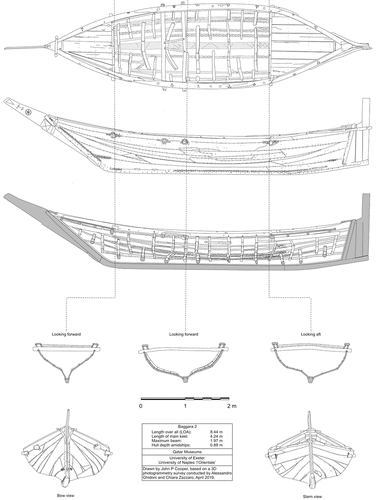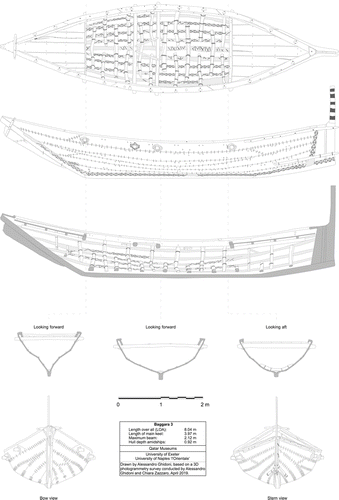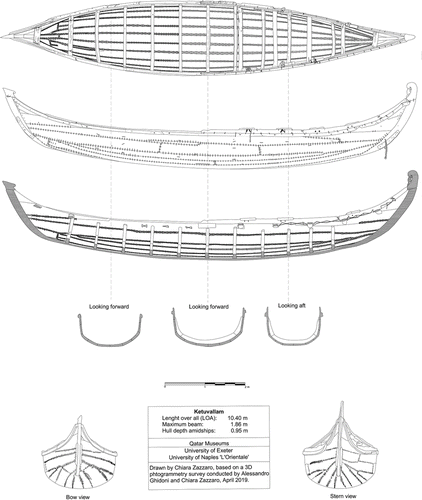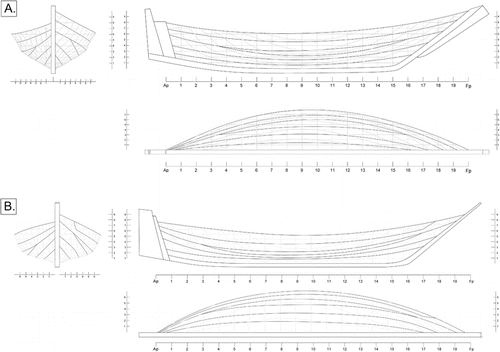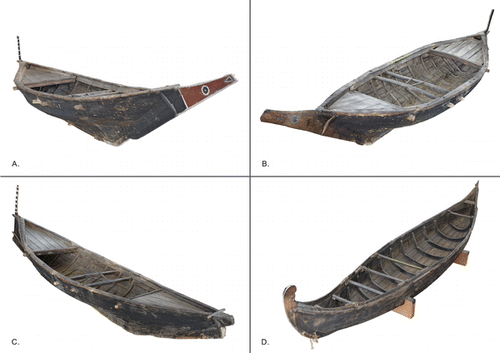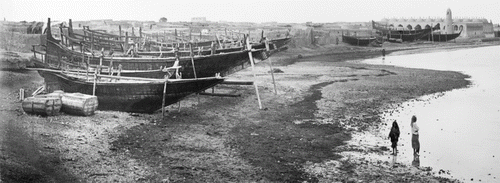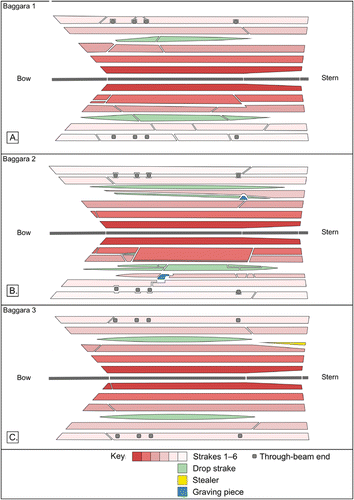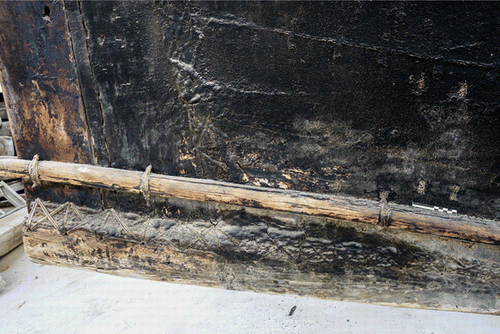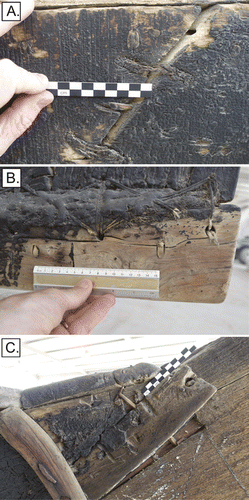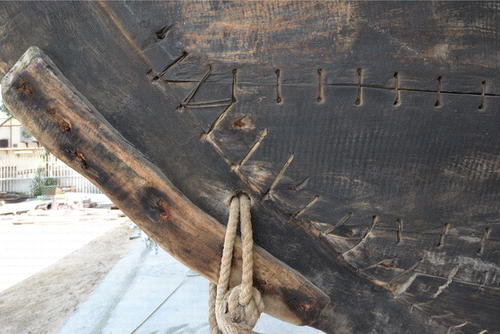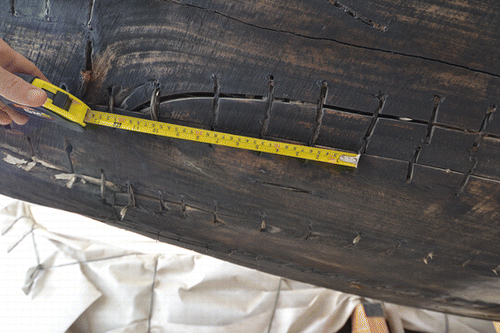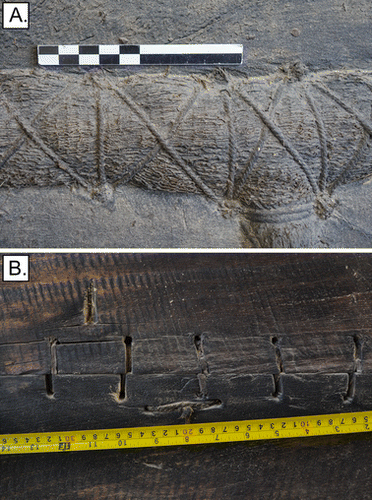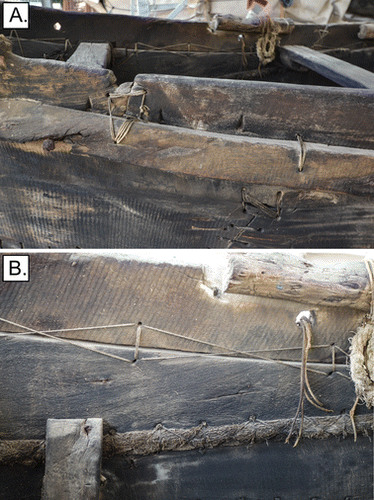Abstract
Vernacular sewn boats from southern Iran and Kerala, India, in the collection of Qatar Museums are documented and their construction described. The Iranian baggāras are unique preservations of sewn boats from the Arabian‐Persian Gulf, notable for their previously undocumented keel‐garboard sewing technique and extensive use of bitumen coatings. Comparison between individual boats enables conclusions to be drawn about the builders’ conception, as well as variation within the type. The Keralite kettuvallams represent an ongoing vernacular tradition that is nevertheless poorly documented or preserved in museum contexts. Construction drawings, naval‐lines drawings, and 3D photogrammetry models are provided for all vessels.
Resumen
Barcos cosidos en la colección de Museos de Qatar en Doha: baggāras y kettuvallams como registros de la una tradición tecnológica del del Océano Índico Occidental
Este artículo documenta y describe la construcción de las embarcaciones cosidas vernáculas del sur de Irán y Kerala, India, en la colección de los Museos de Qatar. Las baggāras iraníes son preservaciones únicas de embarcaciones cosidas del Golfo Arábigo‐Pérsico. Son notables por la técnica de cosido de las tracas de aparadura a la quilla y el uso extendido de recubrimiento de bitumen que previamente no habían sido documentados. La comparación de embarcaciones individuales permite llegar a conclusiones sobre la concepción de los constructores sobre los barcos, así como sobre la variación dentro del tipo. Las kettuvallams keralitas representan una tradición vernácula aún existente que sin embargo ha sido escasamente documentada o preservada en contextos museográficos. El artículo incluye dibujos de construcción, planos de líneas y modelos fotogramétricos 3D de todas las embarcaciones.
Palabras clave: Dhow, baggāra, kettuvallam, barcos cosidos, Qatar, India, Kerala, Océano Índico
抽象
卡塔尔博物馆 (多哈) 藏品中的缝制船:记录西印度洋技术传统的巴加拉和克图瓦拉姆
卡塔尔博物馆对来自伊朗南部和印度喀拉拉邦的土著缝制船藏品登记造册并对其建造方法进行了描述。伊朗的巴加拉船是阿拉伯——波斯湾唯一保存下来的缝制船, 特别是未见于-载的龙骨——龙骨翼板的缝制技术以及沥青涂层的广泛应用。通过对不同船只的比较可导出造-者的建造构想及得出同船型内存在个体差异的结论。喀拉拉的克图瓦拉姆代表-一种持续的土著传统, 但其却缺乏记录, 也很少被博物馆收藏。我们为所有馆-船只制作了结构图、型线图和3D摄影测量模型。
关键词: 阿拉伯-角帆船, 巴加拉, 克图瓦拉姆, 缝制船, 卡塔尔, 印度, 喀拉拉邦, 印度洋
卡塔爾博物館 (多哈) 藏品中的縫制船:記-西印度洋技術傳統的巴加拉和克圖瓦拉姆
卡塔爾博物館對來-伊朗南部和印度喀拉拉邦的土著縫制船藏品登記造冊並對其建造方法進行了描述。伊朗的巴加拉船是阿拉伯——波斯灣唯一保存下來的縫制船, 特別是未見于-載的龍骨——龍骨翼板的縫制技術以及瀝青塗層的廣泛應用。通過對不同船只的比較可導出造-者的建造構想及得出同船型內存在個體差異的結論。喀拉拉的克圖瓦拉姆代表-一種持續的土著傳統, 但其卻缺乏-錄, 也很少被博物館收藏。我們爲所有館-船只制作了結構圖、型線圖和3D攝影測量模型。
關-詞: 阿拉伯-角帆船, 巴加拉, 克圖瓦拉姆, 縫制船, 卡塔爾, 印度, 喀拉拉邦, 印度洋
ملخص
![]()
Recent acquisitions by Qatar Museums (QM), the state museums, archaeology and heritage organization of Qatar, have added a number of sewn boats to its existing collection of watercraft from the Arabian‐Persian Gulf and Oman. Five are fishing baggāras (Arabic ![]() , pl.
, pl. ![]() or
or ![]() ) from the Gulf, while two others are a variety of kettuvallam from Kerala, India. The acquisitions are a rare instance of preservation of significant examples of a broadly western Indian Ocean tradition that is today limited only to parts of India (Moreland, Citation1939a; Citation1939b: 63–64; Hornell, Citation1941; Citation1942: 22; Hourani, Citation1995 (1951): 92–93; Bowen, Citation1952: 202; Prins, Citation1982; Citation1986: 64–94, 100–111; Adams, Citation1985; Kentley, Citation1985; Citation1996; Kapitän, Citation1987: 135–148; Citation2009: 66 ff.; Kentley and Gunaratne, Citation1987: 35–48; Shihab, Citation1987: 41–58; Varadarajan, Citation1993; Citation1998; Vosmer, Citation1993; Citation2005: 236; 2019: 305; Prados, Citation1996: 99; Flecker, Citation2000: 199–200; Citation2001: 336–337; 2011: 101; McGrail, Citation2001: 71–72; Agius, Citation2002: 78–81; Citation2008: 138–140, 148–150; Rajamanickam, Citation2004: 68–71, 87–88, 139–140, 187–192; Camelin, Citation2006: 103–108; Ransley, Citation2009: vol. 1, 88–125, vol. 2, 10–127 (passim); Citation2012; Shaikh et al., Citation2011; Jansen van Rensburg, Citation2016: 114–115; Burningham, Citation2019; Dixon, Citation2019; Fenwick, Citation2015; Citation2019; Ghidoni, Citation2019: 375; Shaikh, Citation2019: 377; Staples and Blue, Citation2019; Weismann et al., Citation2019). The baggāras in particular are extremely rare. They are the first sewn versions of this type of vessel known to academia—it was previously recorded only as a nailed vessel—and are probably the only predominantly sewn boats from within the Gulf held in any museum. They complement four sewn kambārīs held by museums in Oman as representative of the wider sewn tradition of Arabia (Weismann et al., Citation2019). In one respect—the attaching of both port and starboard garboard strakes to the keel in a single, continuous stitching process—baggāras are unique in the scholarly record.
) from the Gulf, while two others are a variety of kettuvallam from Kerala, India. The acquisitions are a rare instance of preservation of significant examples of a broadly western Indian Ocean tradition that is today limited only to parts of India (Moreland, Citation1939a; Citation1939b: 63–64; Hornell, Citation1941; Citation1942: 22; Hourani, Citation1995 (1951): 92–93; Bowen, Citation1952: 202; Prins, Citation1982; Citation1986: 64–94, 100–111; Adams, Citation1985; Kentley, Citation1985; Citation1996; Kapitän, Citation1987: 135–148; Citation2009: 66 ff.; Kentley and Gunaratne, Citation1987: 35–48; Shihab, Citation1987: 41–58; Varadarajan, Citation1993; Citation1998; Vosmer, Citation1993; Citation2005: 236; 2019: 305; Prados, Citation1996: 99; Flecker, Citation2000: 199–200; Citation2001: 336–337; 2011: 101; McGrail, Citation2001: 71–72; Agius, Citation2002: 78–81; Citation2008: 138–140, 148–150; Rajamanickam, Citation2004: 68–71, 87–88, 139–140, 187–192; Camelin, Citation2006: 103–108; Ransley, Citation2009: vol. 1, 88–125, vol. 2, 10–127 (passim); Citation2012; Shaikh et al., Citation2011; Jansen van Rensburg, Citation2016: 114–115; Burningham, Citation2019; Dixon, Citation2019; Fenwick, Citation2015; Citation2019; Ghidoni, Citation2019: 375; Shaikh, Citation2019: 377; Staples and Blue, Citation2019; Weismann et al., Citation2019). The baggāras in particular are extremely rare. They are the first sewn versions of this type of vessel known to academia—it was previously recorded only as a nailed vessel—and are probably the only predominantly sewn boats from within the Gulf held in any museum. They complement four sewn kambārīs held by museums in Oman as representative of the wider sewn tradition of Arabia (Weismann et al., Citation2019). In one respect—the attaching of both port and starboard garboard strakes to the keel in a single, continuous stitching process—baggāras are unique in the scholarly record.
The rarity and importance of the baggāras is augmented by the extensive presence of bitumen on the hulls, applied as a waterproofing, anti‐fouling, and otherwise protective coating. While the use of bitumen on seagoing and river craft is attested in the region from ancient times (Cleuziou and Tosi, Citation1994; Potts, Citation1995; Vosmer, Citation1996; Carter, Citation2002), its recent use on plank‐built vessels—whether in the region's sewn or clenched‐nail traditions—remains little examined.
We apply common English usage in referring to vessels with timbers bound together by continuous cordage as ‘sewn’. This closely reflects Arabic, where the root kh‐y‐ṭ (![]() ) denotes the action of joining (i.e. sewing) both textiles and boat timbers (Wehr, Citation1976: 267–268; Agius, Citation2008: 161–168; al‐Salimi and Staples, Citation2019: 63–65). It less effectively reflects Malayalam, where the term kettuvallam means ‘tied (or bound) boat’, the action kettuka, meaning ‘tying’ (Ransley, Citation2009: 5 (§5), 18; Citation2012: 247–248) or ‘binding tight’ (Gundert, Citation2013 (1872): 205).
) denotes the action of joining (i.e. sewing) both textiles and boat timbers (Wehr, Citation1976: 267–268; Agius, Citation2008: 161–168; al‐Salimi and Staples, Citation2019: 63–65). It less effectively reflects Malayalam, where the term kettuvallam means ‘tied (or bound) boat’, the action kettuka, meaning ‘tying’ (Ransley, Citation2009: 5 (§5), 18; Citation2012: 247–248) or ‘binding tight’ (Gundert, Citation2013 (1872): 205).
Research goals
This article is the outcome of fieldwork that had as its primary objective the detailed documentation of QM's sewn watercraft for the first time. The principal visual outputs—construction drawings, naval‐lines drawings, and 3D digital models based on photogrammetry—are presented (Figs 11–7; see also supplementary materials). The fieldwork further sought to understand the processes and techniques deployed in building the craft, as well as the variety occurring among them. A further objective—to be addressed in a separate publication—was to compare the use of bitumen on the hulls of the baggāras with fragments recently found at Fuwairit in north‐eastern Qatar by an archaeological team from University College London‐Qatar led by Robert Carter: these may relate to nautical activity (Carter, pers. comm., 23 November 2019).
Methodology
QM kindly granted access to the vessels at its Dhow Section in Doha in April 2019, preparing and positioning the boats for survey. The authors undertook a programme of 3D photogrammetric survey and close visual inspection of the QM vessels.
3D photogrammetry
The authors carried out three photogrammetric surveys per boat using a different camera each time: a Nikon D310 digital SLR, a Sony Cyber‐shot DSC‐RX100 II compact camera, and a GoPro Hero 3+ action camera. The triplication enabled comparison of the data obtained across the devices and selection of the best for the intended use, as well as mitigating against camera failure.
The two‐stage process began with the team taking series of overlapping photographs of each vessel from a relatively fixed distance in a sequence of orbits around the boat. The limited space between the vessels necessitated the use of wide‐angle lenses (Tamron 10–24 mm, 1:3.5–4.5 on the Nikon camera): the Metashape Pro photogrammetry softwareFootnote1 is capable of correcting the resulting distortion (Fiorillo et al., Citation2016: 69–70). The authors took as many as 767 photographs gathering their first set of photographs, for baggāra 1, but later reduced this to 418 for the kettuvallam. The second stage involved processing the photographs in Metashape Pro, which generates 3D point clouds from the still images (Yamafune et al., Citation2017: 3). The files produced can be scaled and measured with a high degree of accuracy (cf Martorelli et al., Citation2014: 91).
Construction drawings
The authors reverse‐engineered conventional construction drawings from the photogrammetry models. Screenshots were taken of orthographic views of the plan, profile, bow, and stern of the 3D models, plus a longitudinal and three lateral cross‐sections. These were then imported into one or other vector‐drawing software programs (Affinity Designer for Cooper's drawings; VectorWorks for Ghidoni's; Autocad for Zazzaro's), and the visible structure traced. Areas of blinding, especially under the fore and quarter decks, presented a challenge to tracing, as did the dark bitumen colour: these were mitigated by continued reference to still photographs and field notes. The final drawings are presented in Figures 11–4. The principal dimensions and ratios, plus comparisons with other western Indian Ocean sewn craft are presented in Table .
Table 1 Principal dimensions and ratios of the Qatar Museums sewn boats, with comparisons to other published sewn watercraft of the Western Indian Ocean
Naval‐lines drawings
The conventions of naval‐lines drawings rest on the presumption of a longitudinal reflectional symmetry in the hull that few vernacular vessels have in reality: modelling the buttock and half‐breadth lines of only one side of the hull, following convention, would therefore generate a misleading representation of moulded form. Meanwhile, the 3D mesh models that were generated through the photogrammetry process provide the necessary basis for any future hydrodynamic modelling of the actual hulls. Instead, the authors generated ‘edge‐shaped’ lines drawings for the baggāras, presenting an idealized representation of the hull that is nevertheless extrapolated from actual dimensions: essentially, any mutual deviations in port‐starboard symmetry were mathematically ‘smoothed out’ (Figs 55A‐B and 6A). This approach preserves the particular polyhedral geometry of the hull, and can be seen as presenting the underlying ‘archetypal’ concept of the hull, while at the same time excluding irregularities introduced in the execution of the build (Ombrato et al., Citation2020). For example, the builder of baggāra 3 has inserted a small triangular plank towards the bow in order to achieve the desired degree of curvature.
The lines drawings were produced initially by creating actual curves from the mesh models generated from the 3D photogrammetry. The mesh was divided into eight equal parts and sliced to produce seven each of half‐breadth lines, buttocks, and waterlines. As expected, the resulting lines proved highly asymmetrical. In order to obtain the final ‘edge‐shaped’ representation, the principal ‘edges’—angles found along the planking seams of the hull—were traced onto the mesh model, before starting the slicing. The curvatures of each side were then mirrored, overlapped, and mediated with the curve on the opposite side, and the final edge‐shaped hull lines created. Because the drawings simply mediate the asymmetries, they remain a valid basis for generating moulds in any reconstruction scenario.
The less faceted and more symmetrical hull of the kettuvallam allowed the authors to produce only the conventional form of naval‐lines drawing (Fig. 6B).
Provenience and context
Little is known of the provenience of the sewn baggāras, except that QM acquired them in Hormuzgan province, southern Iran, in 2013. Whether sewn or nailed, vessels known by this name were in the previous century found on both sides of the Gulf and in the Gulf of Oman between Musandam and the northern Batinah coast (Lorimer, Citation1915: 2323; Howarth, Citation1977: 46; Shihāb, Citation1987: 53; Vosmer, Citation1997: 219; al‐Hijji, Citation2001: 11–12; Weismann et al., Citation2014: 418). An 1898 model of what appears to be a large sewn baggāra from the Horniman Museum, London bears a label saying it operated throughout the Gulf.Footnote2
Agius (Citation2002: 106–107) traces the word baggāra through text as far as the 18th century CE, and suggests the term might be Persian—although al‐Salimi and Staples (Citation2019: 48–49) argue it might relate to the Arabic word baqara (![]() ), meaning ‘cow’, given the vessel's somewhat bovine stem‐head. In any case, textual mentions are problematic because they might refer to a variety of vessel types and construction methods. Native speakers apply the term to indicate the vessels described here or a range of similar, predominantly nailed, boats from south‐eastern Arabia—the already mentioned ‘Emirati baqqārah’, the shāhūf (
), meaning ‘cow’, given the vessel's somewhat bovine stem‐head. In any case, textual mentions are problematic because they might refer to a variety of vessel types and construction methods. Native speakers apply the term to indicate the vessels described here or a range of similar, predominantly nailed, boats from south‐eastern Arabia—the already mentioned ‘Emirati baqqārah’, the shāhūf (![]() ), zārūqa (
), zārūqa (![]() ), and battīl (
), and battīl (![]() ), which vary in length from 4.5–20 m (Lorimer, Citation1915: 2323; Howarth, Citation1977: 45–47; Facey, Citation1979: 142; Shihāb, Citation1987: 113–117; Vosmer, Citation1997: 219–230; al‐Hijji, Citation2001: 13; Agius, Citation2002: 105; Weismann, Citation2005; Weismann et al., Citation2014). These have in common a double‐ended hull, straight, raking stem, stern fin (fashīn) and angled, two‐part keel with a rocker aft (Vosmer, Citation2005: 306). Some, such as the Omani battīl and badan, had their stem and stern posts sewn (Facey, Citation1979: 144; Shihāb, Citation1987: 53; Agius, Citation2002: 111), perhaps as an intermediate stage in a sewn‐to‐nailed transition. The QM baggarās have strong similarities to the Omani zārūqa and battīl: fashīn shape and hull profile resemble those of the former, while their size and sewn through‐beams resemble the latter.
), which vary in length from 4.5–20 m (Lorimer, Citation1915: 2323; Howarth, Citation1977: 45–47; Facey, Citation1979: 142; Shihāb, Citation1987: 113–117; Vosmer, Citation1997: 219–230; al‐Hijji, Citation2001: 13; Agius, Citation2002: 105; Weismann, Citation2005; Weismann et al., Citation2014). These have in common a double‐ended hull, straight, raking stem, stern fin (fashīn) and angled, two‐part keel with a rocker aft (Vosmer, Citation2005: 306). Some, such as the Omani battīl and badan, had their stem and stern posts sewn (Facey, Citation1979: 144; Shihāb, Citation1987: 53; Agius, Citation2002: 111), perhaps as an intermediate stage in a sewn‐to‐nailed transition. The QM baggarās have strong similarities to the Omani zārūqa and battīl: fashīn shape and hull profile resemble those of the former, while their size and sewn through‐beams resemble the latter.
In the Qatar and the United Arab Emirates, and more generally in the southern and western shores of the Gulf, smaller baggāras—such as those in the QM collection—were used for coastal fishing, and were generally rowed. The larger versions (cf Fig. 8) were used for pearling and carrying cargo, and had one or two masts and a crew of 15–30 (Lorimer, Citation1915: 2323). In Oman, the baggāra of the mid to late 20th century was a medium‐sized vessel of nailed construction, ranging in length 25–35 ft (7.6–10.7 m) used for fishing and cargo (Facey, Citation1979: 143; Agius, Citation2002: 105). Its geographical distribution—between that of the battīl of Musandam to the north and the badan of the coast of southern Batinah and Muscat to the south—is reflected in commonalities in shape and construction with both these vessels (Vosmer, Citation1997: 230).
Iconographic evidence for baggāra‐like vessels is limited. The gharookuh illustrated by Pâris while visiting Muscat in 1839 (Citation1841: 13–14, Plate 5), is among the earliest: he says it occurred in the Gulf and travelled as far as Kerala. It has features common to both the baggāra and battīl, such as the raking bow, fashin, and angled keel; however, the stem‐head makes it closer to the former. Although the Horniman Museum model is labelled only as an ‘Arab Vessel’, Weismann (unpublished report Citation2005) identifies it as a baggāra on the basis of the stem‐head, even though its fashīn resembles that of a battīl. Evidence for the existence of baggāra‐like vessels in Qatar itself comes from the rock carvings of vessels in profile at Jabal Jusasiyah in the north‐west of the peninsula (Kapel, Citation1983: 53–55, fig. 99–11; Facey, Citation1987: 200–201, 211, fig. 4). These have been recently dated to 235 years before present (Hassiba et al., Citation2012: 13).
Figure 9 Construction features of the keels and posts of the QM baggāras: A) oblique dowels in the keel of baggāra 2, fixing the garboard strake; B) the jointing of the keel to the ‘false’ outer stem of baggāra 1, with perpendicular dowel suggesting the locking of inner jointing; C) rabetting of the outer stem of baggāra 2 around the hood‐ends; D) a short run of |X|X|X| stitching on the outboard hull of baggāra 2, related to the stitching of the ‘false’ outer stem; E) stitching of the hood‐ends of baggāra 1 direct to the first plank of the fashīn; F) stitching of the hood‐ends of baggāra 2 to a dedicated sternpost timber: the stitching has been removed. (Images: John P. Cooper, Alessandro Ghidoni, Chiara Zazzaro).
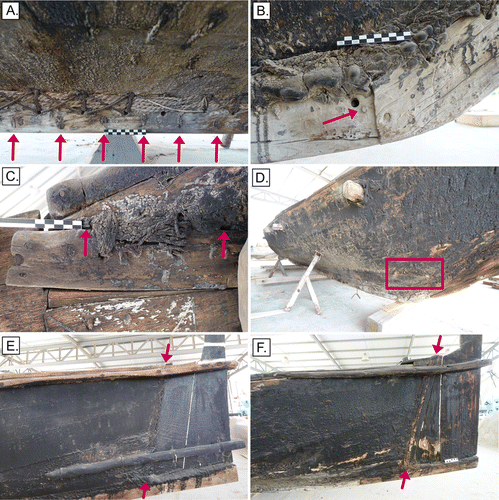
Figure 11 A) The prow timber on QM baggāra 1; B) detail of its widely spaced lashings. (Images: Alessandro Ghidoni and Chiara Zazzaro).

QM acquired the kettuvallams in 2012 from a private individual, the only provenience being that they came from Kerala. Photographic evidence suggests that they are amphidromous. There is a dearth of published literature on Keralite sewn vessels, despite it being one of the last strongholds of sewn construction in the Indian Ocean. Rajamanickam's study of Indian watercraft (Citation2004: 68–71, 102) lists a number of ‘stitched plank‐built boat[s] without keel’ in Kerala, but the QM boats correlate to none of them precisely. Other, earlier studies on Indian watercraft, such as by Edye (Citation1834), Pâris (Citation1841), and Hornell (Citation1920, Citation1946) focus on vessels from other Indian regions, while Hornell states—incorrectly—that vessels from Kerala can be divided into dugouts and planked ‘pseudo‐dugouts’, remarking (bizarrely) for the latter that ‘there is so little variation … that there is almost nothing to say of them’ (Citation1920: 150). What little recent research there has focused on riverine vessels, such as those of the backwaters around Alleppey (Ransley, Citation2009), or sewn boats from neighbouring regions (Kentley, Citation19851985; 2003a; Citation2003b; Shaikh et al., Citation2011; Fenwick, Citation2015; Shaikh, Citation2019).
Rajamanickam's description of what he calls a kettuvallam (Citation2004: 68–69) bears some similarity to the QM vessels: both are double‐ended and sewn, with a crescent‐shaped profile and U‐shaped cross‐section. Neither have a proper keel: the flat, central ‘keel plank’ has the same thickness as the rest of the hull. The stems and sterns of both vessels are fastened only to the top strakes. Rajamanickam says his kettuvallam can measure up to 20 m in length, while only 1.35 m wide and 0.9 m deep at midships. Frames, spaced around 1 m apart, give the hull structural strength, as do a series of thwarts. Rajamanickam provides only one small photograph and a lines plan to illustrate his kettuvallam (Citation2004: 70, fig. 11, 116, pl. 19). Unfortunately, his photograph gives limited information and the purported lines drawing is of an entirely different vessel. This lack of information makes our identification of the kettuvallams by that name tentative. The term is generic for a vessel fastened with cordage (Ransley, Citation2009: 18; Citation2010: 429). Early Tamil and more recent Malayalam works of literature mention also the term but provide no details of form (Greeshmalatha, Citation2013: 33; Rajamanickam, Citation2004: 64).
Keralite fishermen use the kettuvallam for coastal fishing. They launch through the surf and propel the vessel with oars, steering with a paddle (Hornell, Citation1920: 150; Rajamanickan, Citation2004: 69).
Patrice Pomey briefly describes kettuvallams in two articles (2012; Citation2011: 138–139) and in a documentary film (Pomey and Raymond, Citation2012: minute 08.30). His interest in these boats is primarily directed at their sewing technique, which is very similar to that of Greek archaic sewn boats found in Marseille, France (Pomey, Citation2012: 126–127, fig. 17). In both articles Pomey states that kettuvallam are from the Malabar coast and identical in technique to those of the Lakshadweep islands. The documentary provides unique evidence of maintenance and construction tools.
Condition of the vessels
The QM baggāras are in varying states of repair (Fig. 8). The three presented in this article have a high degree of structural integrity, but show deterioration around key areas of stitching, in particular along internal and external portions of their garboard‐keel jointing, and also at their posts. Plank stitching and its wadding is also worn internally in areas of greatest traffic.Footnote3 Baggāra 3's prow timber—the term we use to designate the carved, decorated, and possibly sacrificial timber that establishes the vessel's bow profile—is broken off (Fig. 3). Baggāra 1 showed signs of dry rot on some planking.
The two baggāras not discussed in this paper are in significantly poorer condition. These were wrapped in geotextile at the time of the survey, and the authors did not inspect them in detail: however, their keels were visibly weakened by past infestations of marine boring organisms.
The two Indian kettuvallams, meanwhile, are in a robust state.Footnote4 The timbers are largely intact and show no signs of deterioration beyond general wear; the stitching and wadding remain in place and tight throughout.
Construction sequence
The QM sewn boats are built according to variants of a shell‐conceived system of sewing and lashing that is one of two principal western Indian Ocean boatbuilding traditions—the other being the clenched‐nail system (Hourani, Citation1995 (1951): 92–97; Yajima, Citation1976: 25–27; Howarth, Citation1977: 20; Shihāb, Citation1987: 41–112; al‐Hijji, Citation2001: 44–76; Agius, Citation2002: 143–145). In the sewn tradition, hull planking is joined by continuous stitching along a flush seam, usually leaving a |X|X|X|X| pattern inboard, with plugged holes. In the Arabian tradition—and, on the evidence of the baggāras, the Iranian—the planking is aligned using wooden dowels fixed into the faying surfaces (Bowen, Citation1952: 220–221; Prins, Citation1986: 87–89, 100–109; Prados, Citation1996: 101; Vosmer, Citation1997: 233–234; Weismann et al., Citation2019: 354–356). Many Indian and Sri Lankan sewn boats do not have dowels (Kentley, Citation2003a, 142; Citation2003b, 174–175; Fenwick, Citation2015, 393; Citation2019: 389); builders sometimes make use of plank edge‐grooves instead (Shaikh et al. Citation2011: 152).Footnote5 The 8th‐century‐CE Phanom‐Surin and 9th‐century‐CE Belitung wrecks also have no dowels visible in their hull planking (Abhirada Komoot, pers. comm. 29 April 2020; Flecker, Citation2000: 200), although the Phanom‐Surin wreck has not yet been fully investigated.
Outboard, the planking stitches on the QM vessels are set into vertical rebates between the stitch holes, creating a | | | | | pattern; inboard, the stitching is over a continuous pad of wadding; this is vegetal in the baggāras, and in the Indian kettuvallams is composed of a fine netting of unknown material. Framing timbers are fixed with lashings in both vessel types.
Baggāra construction
The inferred construction sequence of the baggāra is as follows.
Keel and posts
The construction process begins with the builders laying a keel comprising two end‐butted timbers with a broadly U‐shaped or rounded‐trapezoidal cross‐section, similar to the sewn kambārī in the Museum of the Frankincense Land, Oman (Weismann et al., Citation2019: 349), the Goan revenchem vodem (Shaikh et al., Citation2011: 151) or East African mtepe (Prins,Citation1986: 84). The keel's longer forward timber represents about two‐thirds of the total keel lengthFootnote6 and has an upward‐curving forefoot that joins an outer (‘false’) stem. The keel's shorter aft timber rakes upward—at 12° on baggāra 1, and at 10° on baggāras 2 and 3—and is slightly curved at its forward end (Figs 11–3). The internal joinery of these two vital timbers is unknown. It is improbable they are simply end‐butted, given the forces in play during both construction and life of the baggāra, but there is no indication of any internal joinery visible externally.
Likewise, the presence of stitching and wadding inboard and outboard along the keel's length—together with the in situ garboards—made it impossible to ascertain whether the builder of the QM baggāras rabbeted the keel to receive the garboard strakes, something common in regional clench‐nailed boatbuilding (Millward, Citation1951: 198–199; Hawkins, Citation1977: 102; Howarth, Citation1977: 63; Facey, Citation1979: 158; al‐Hijji, Citation2001: 44–49; Agius, Citation2002: 150–153) and also seen on the sewn battīl and at least some Omani kambārīs (Vosmer, Citation1997: 224; Citation2005: 332; Citation2019: 309), the Yemeni sewn sanbūq (Prados, Citation1996: 100), and the Goan revenchem vodem (Zeeshan Shaikh, pers. comm., 19 October 2019). The fact that a portion of the upper face of the baggāra's keel steps outwards suggests unseen rabbets (CitationWeismann et al., 2019: 350). An alternative explanation might be that the builders carved longitudinal lugs along the keel's upper face to prevent the garboard strakes from slipping inward, an approach adopted by the builders of the Belitung wreck (Flecker, Citation2000: 202), but with no recent ethnographic parallel.
The existence of these steps rules out the possibility that the QM baggāras’ garboard strakes are simply butted against a bevelled upper corner of the keel. Weismann et al. (Citation2019: 350) infer that bevelling is ‘probably’ the configuration on the four museum‐held kambārīs in Oman. However, they note (Citation2019: 343–344) that the two kambārīs on display at the Fatah al‐Khair Centre in Sur, Oman, were all built by the same builder for museum display, rather than as working boats. Weismann suggests this might be a factor in their divergence from kambārīs observed ethnographically (pers. comm., 24 October 2019).
Another feature of the garboard‐keel jointing in the QM baggāras is the sequence of obliquely cut wooden dowel heads apparent along the length of the keel—at the rate of one per keel‐garboard stitch (Fig. 9A). One function would have been to hold the shaped garboards in place in readiness for stitching, but their close spacing suggests a long‐term fixing role. By measuring the ends of the dowels cut flush with the keel's moulded faces, it is possible to infer their angle of insertion and calculate their paths through the keel. Amidships, for example, the dowels of baggāra 3 form angles of between 33˚ and 40˚ with the keel's moulded side. This angle deviates too much from the vertical to allow it to fasten the garboard on the same side of the hull: rather, it suggests that the builders of the baggāras drove the dowels diagonally through the lower edge of one garboard and through the keel, emerging on the keel's opposite moulded face.
The use of dowels to align and anchor the garboard is also seen on the working kambārī from Taqa in the Oman Across the Ages Museum (OAAM) in Manah, Oman (Weismann, pers. comm., 24 October 2019). Professor Dionisius A. Agius of the University of Exeter also showed the authors a photograph he took of a kambārī in Taqa in 1996 that also shows such dowels.
The builders of QM baggāras 1 and 2 set the stem at around 38° to the keel, while that of baggāra 3 was set at a more raking 35°. The nature of the joinery fastening the keel to the stem posts—the ‘false’ outer one and, where present, the inner one—is again unknown due to its concealment. However, at least some use of oblique dowels is evident on the joinery of the false outer stem to the keel on baggāra 2—including, apparently, some pegged dowelling (whether intentional or coincidental). The visible heads of horizontal dowels driven perpendicularly into the keel alongside this joint on baggāra 1 also suggest these are acting as locks to an unseen internal joint (Fig. 9B). In comparison, Flecker (Citation2000: 201–202) reports a lightweight mortice and tenon arrangement in the keel‐to‐stem joinery of the Belitung wreck, which he suggests was for initial alignment rather than structural strength. In the sewn revenchem vodem of Goa, meanwhile, the stem is obliquely stop‐tenon‐jointed into the keel before the planking is laid: the joint is also locked, using a ‘small wooden block’ (Shaikh et al., Citation2011: 151).
A parallel for the construction of the baggāra bow section may be Vosmer's interpretation (1997: 229) of the sewing‐on of the false outer stem of the otherwise‐nailed Omani battīl, the hood‐ends of which are sewn together before the post is affixed. In the case of QM baggāra 2, the hood‐ends appear to have been brought together around a fine internal stem of trapezoidal cross‐section. No comparable internal stem was visible on baggāras 1 and 3, although these might have been concealed beneath stitching and wadding. By analogy with Vosmer's battīl interpretation, it would have been after the stitching together of the hood‐ends that the false outer stem was affixed to the bow: by means of a second run of stitching. Prados (Citation1996: 103) also observed the practice of attaching the outer stem after the stitching together of the hood‐ends in the Yemeni sewn sanbūq. Meanwhile, Chittick (Citation1980: 299–300) notes that the Somali builders of the beden added the stem and stern posts after the third strake had been fixed. On baggāra 2, the false outer stem is rabbeted at its upper end to accommodate the hood‐ends, but lower down it is simply butted (Fig. 9C).
A further corroboration of the battīl analogy is the presence on all three of the QM baggāras of a short run of outboard stitching running back from the stem for about 0.30 m along the seam between the garboard and second strakes (Fig. 9D). Vosmer (Citation1997: 229) observed this same feature on the false stem on the otherwise‐nailed Omani battīl. This is unlike the approach taken by builders of the Indian masula, who join the stem and stern posts and hood‐ends together in a single sewing action (Kentley, Citation1985: 307).
The lack of visibility of the internal jointing again hampered interpretation of the builders’ approach(es) to bringing the hull planking together at the stern. In baggāra 1, and probably also 3, the builders butted the hood‐ends directly against the forward moulded face of the first plank of the fashīn—the upright ‘fin’ at the stern—and stitched this assemblage together (Fig. 9E). However, in the case of baggāra 2, the builders brought the hood‐ends together at a dedicated, though still lightweight, sternpost that is set along the rake of the hood‐ends (Fig. 9F): at the time of inspection, there was no surviving stitching holding this joinery together, but holes indicate it had once existed.
The planks of the fashīn are aligned using concealed dowels, and the whole held in place by two cheekpieces, the lower one lashed in place, and the upper one nailed.
Planking
The planking of the baggāras is c.25 mm—being 1 inch—thick with a surface kerf that is straight and parallel but of variable spacing, consistent with use of a band saw (Williams, Citation2008: 114). The Imperial dimension and machine‐cutting technique are suggestive of a long‐distance commercial timber‐supply chain. The bituminous coatings on the planking made it difficult to establish how the planking had been cut, although the authors suppose the through‐and‐through method was used (Kentley, Citation1985: 307). The species of timber used for the planking is/are unknown.
The fayed edges of the planking are largely obscured by neat seams, wadding, and bitumen, making close inspection of any tooling difficult. However, a gaping scarf joint on baggāra 2 revealed a variability on the joint's faying surfaces consistent with use of an adze or chisel—common tools in regional boatbuilding (Agius, Citation2002: 141; al‐Salimi and Staples, Citation2019: 189). The same joint also revealed the deployment of dowels driven obliquely from one plank‐end to the other, from outboard to inboard, securing the scarf. Meanwhile, the necessary tapering of the breadth of the planking along its length to realize the overall hull shape, as well as variation of the angle of the planking edges to achieve watertight seams, would also have required the skilled use of an adze, or perhaps a plane. Because the builder cannot access sewn seams after the stitching is complete, the kind of caulking seen in the region's nailed vessels cannot be applied: instead, luting is necessary (see below).
All three baggāras show their builders’ preference for diagonal scarf jointing of the planking (Fig. 10), in contrast to the butt joints seen, for example, on the Belitung (Flecker Citation2000: 206) and Phanom‐Surin wrecks (First Regional Office of Fine Arts, Citation2016: 45, fig. 45; Guy, Citation2017: 179, 181: figs 11–2). They also show a broadly similar conception in overall planking arrangement: with three full strakes immediately above the keel, two immediately below the sheer line, and the roundness of the hull amidships achieved via the insertion of one or more drop‐strakes between full strakes 3 and 4. Beyond that, however, they differ from each other in significant respects. Baggāra 3 shows the most consistent and symmetrical approach to planking. Both sides follow the above concept closely, with a single drop‐strake on each side (Fig. 10). The builder's positioning of scarf joints on the upper strakes is also highly systematic, with port and starboard scarf mirroring each other, and a scarf set forward on one strake alternating with those on the strakes above and below set aft, thus distributing the weak points created by the scarfs. The only asymmetry on baggāra 3 was a scarf joint close to the forward end of the port garboard strake, and a small stealer in the third starboard strake, perhaps inserted to deal with a plank imperfection. Meanwhile, the through‐beams pierce strake 5 centrally on both sides. Neither of the other baggāras achieve such symmetry.
Baggāra 1 has some notable divergences from the general planking concept (Fig. 10). There is a tendency below the turn of the bilge to use planks of varying width, necessitating joggle jointing not found in baggāra 3, while the drop‐strakes and upper strakes tend to comprise numerous short timbers. The implication is that the builder(s), or perhaps repairers, of baggāra 1 were more constrained in their timber options than those of baggāra 3, while seeking to achieve a similar overall planking concept.
The most irregular planking occurs on baggāra 2 (Fig. 10). The same broad zones are apparent, but are much more irregular. Both sides have a single plank comprising the garboard strake. On the starboard side, this is followed by two more single‐plank strakes, as in baggāras 1 and 3. However, on the port side, the place of strakes 2 and 3 is taken amidships by a single, large, ‘double‐width’ plank. Forward and aft of this wide plank, strakes 2 and 3 ‘reappear’ as separate planks: Kentley (Citation1985: 307) observes a similar combination of two strakes into what he calls a ‘broad strake’ in some sewn masulas in Orissa, India. Meanwhile, around the turn of baggāra 2's bilge, there is on both sides of the vessel a highly irregular arrangement of drop‐strakes, stealers and graving pieces comprising multiple timbers (Figs 2 and 10). Above, the two upper strakes complete the hull in a regular manner on both sides.
This variation in planking plans between the three baggāras is informative. The uniformity and symmetry of baggāra 3 suggests an experienced builder with a clear hull concept in mind and planks available of sufficient quality, quantity, and length to execute it. This uniformity perhaps also suggests a vessel near the start of its working life, before the disruption of subsequent repairs. However, the planking plans of baggāras 1 and 2 show a variability in execution—if not overall conception—that stands in marked contrast. However, they suggest no less skill or overall conception in the minds of their builders. What they do suggest is an imperative to economize on timber and optimize what was available. This is suggested in the proliferation of shorter timbers and scarf joints, particularly above the waterline. The incorporation of relatively short and/or broad planks in baggāras 1 and 2 likewise suggests the opportunist incorporation of available, perhaps reused, timbers.
The incorporation of a single, extra‐broad plank amidships on the port side (only) of baggāra 2 appears a particularly unexpected choice on the part of the builder. As the construction drawings for this vessel show, this has a particularly deleterious effect on hull symmetry. Inexperience or a lack of skill on the part of the builder is an alluring explanation. However, the multiple small timbers used around it to create the drop‐strake and incomplete strake 4 actually imply a certain confidence in the builders’ stitching skills, and a creative improvisation in the deployment of limited timber resources. Given the asymmetry, it is possible, perhaps likely, that the incorporation of this timber was part of a later repair.
There is no visible evidence on the baggāras—largely due to the bitumen coating—to indicate how the curvature of individual planks was achieved. It may have been through the application of fire, together with twisting force, as observed directly by Cooper and Ghidoni in Zanzibar,Footnote7 and also Shaikh et al. (Citation2011: 152) in Goa, Kentley in Sri Lanka (Citation2003a: 171–173) and Wenban‐Smith in Tanzania (Citation1963: 167, 171). Ghidoni (Citation2019: 368) also used this approach in the project to build a replica of the beden seyad in Oman. Kentley (Citation1985: 307) reports no use of heat or steam to shape the planking of the sewn Indian masula, however.
Planking and framing sequence
The builder(s) would have fixed the two pre‐shaped garboard strakes of the baggāras to the keel using the dowels and continuous sewing technique as mentioned. They would probably have used a traditional forked marking gauge (Ar. qalam) made from a partly split stick to mark with a coloured pigment the portions of the plank requiring reduction (al‐Hijji, Citation2001: 150). Achieving a close fit against the keel would also require the builder to adze or chisel the lower faying surface of the garboard to an angle that would have to change progressively along its length: acute amidships, and obtuse at the ends. The precise manner of stitching the garboard strakes is set out below.
With the garboard strakes fixed, the second and third strakes could then be added progressively. At this point, the sharp curvatures of the strakes probably still require the planks to be heat‐shaped, possibly with weighted levers applied amidships, in order to ensure the required beam of the complete hull.
The framing timbers of the QM baggāras were, without exception, grown crooks selected for their natural approximation to the curvature of the hull at the desired point of attachment. While the planks were probably sourced further afield, these timbers might have been sourced locally, with Ziziphus spina christi, Acacia nilotica, or varieties of mangrove as species candidates, depending on place of construction (Vosmer, Citation1997: 218–219; Citation2005: 96–97; Weismann et al., Citation2014: 427, 429; Agius et al., Citation2016: 143–146). These would have been shaped by axe and adze, probably using a bendable metal rod (or similar) as a mould to transfer the curvature from the hull and a qalam to mark where material needed to be removed; the initial curvature of the hull itself would have been previously established, probably by setting four or so frame stations, the dimensions of which would have been transferred from a pre‐existing vessel or moulds. The upper sided face of each floor has recesses to accommodate and prevent abrasion of the lashings.
The floor‐timbers of the baggāras do not, generally, extend beyond the seam between the third and fourth strakes (or third strake and drop‐strake). Hence, they could have been attached at this stage in the process in order to brace the hull in its achieved shape. This is the approach that the builders of the Omani battīl took (Vosmer, Citation1997: 224), as did Severin (Citation1985: 285) in his Sohar reconstruction. Prados (Citation1996: 104) says this approach was also feasible on the Yemeni sewn sanbūq, and we suggest it might also be the case for the similar Omani kambārīs that Weismann et al. (Citation2019) describe. The subsequent planking could afterwards be built up as far as the penultimate strake, presumably using the same bendable metal rods as moulds. This interpretation nuances discussion of longitudinally sewn boats generally as being inherently of ‘shell‐first’ construction (Pomey and Boetto, Citation2019: 6–7).
Once the baggāra builders reached the penultimate strake, their attention would have turned to fixing the four through‐beams that brace the upper portion of the hull. There is some variety between the baggāras in how the beams are accommodated into the planking. In baggāras 1 and 2, recesses are sometimes cut into both the penultimate and sheer strakes (Fig. 10B), while in others, only the sheer strake is recessed (Fig. 10A), with the beam simply sitting on the top edge of the penultimate strake. In baggāra 3, full holes have been cut through the sheer strakes (Fig. 10C). In all cases, we presume the builders notched the beams in order for them to sit on the plank and prevent lateral movement, but could not confirm this because of the extant beam‐end stitching.
Two of the beams on baggāra 1 are probably reused keels, given the proliferation of obliquely set vestigial dowels found along their length; a similar reused piece formed the outer stem of baggāra 2.
Once the builders had fixed the through‐beams and sheer strake in place, the natural‐crook half frames could be shaped with an axe or adze, again using a qalam and mould, and lashed into place within the hull in a manner discussed below. Again, the sided face of each timber has recesses cut into it to accommodate the lashings.
With all major structural timbers fixed, the builders could fit the gunwales and deck planks into place—this time with nails. The fashīn and prow timber could be added any time after the hull planking was complete and the relevant posts were in place. Both are attached to their counterpart timbers using internal wooden dowels and held in place by cheek pieces. In addition, the prow timber is fixed with light and loosely spaced lashings (Fig. 11). In all three baggāras, the lower cheek pieces are lashed into place, while the upper ones are nailed.
Fastenings
Three principal types of fixing occur on the QM baggāras: stitched and lashed cordage (Table ); wooden dowels (Table ); and ferrous nails. Stitching and dowelling are the main fixing methods on the hull, being used to edge‐join planking and attach major timbers such as the keel, posts, and beams. Lashing is used to connect the framing timbers and lower cheek pieces to the hull planking.
Table 2 Indicative characterisations of the cordage of the Qatar Museums sewn boats
Table 3 Indicative dimensions of the dowels of the Qatar Museums baggāras
The cord used to stitch and lash all three baggāras is two‐ply and (mostly) S‐laid, made from a fine, relatively pale plant fibre of unknown species. It is generally 3 mm in diameter, sometimes 4 mm (Table ). Ethnographic and experimental‐archaeological parallels suggest coconut coir as a likely candidate, but no scientific species identifications have been made.
The function of the wadding is to tension the cordage, not least by swelling when wet, thus improving the water‐tightness of the seam beneath; it also cushions the cordage against wear, especially at the edges of the sewing holes, and against the shock of hull impacts (Kentley, Citation1996; Vosmer, Citation2005: 175). For the most part, the inboard wadding of the baggāras comprises long strands of an unidentified grassy plant material laid loose along the seams before being over‐sewn (Fig. 12A, B). Where wadding occurs outboard, it comprises a coarse‐fibred cordage (Fig. 12C).
Figure 12 Wadding materials on the QM baggāras: A) grassy wadding over the inboard seams between the garboards and the keel on baggarā 1; and B) on the planking seams of baggāra 3; C) fibre ropes stretched along the outboard seam of the keel and garboards on baggāra 2; D) a small section of possible repair wadding made of a reed‐like plant inboard on baggāra 1. (Images: John P. Cooper, Alessandro Ghidoni, Chiara Zazzaro).
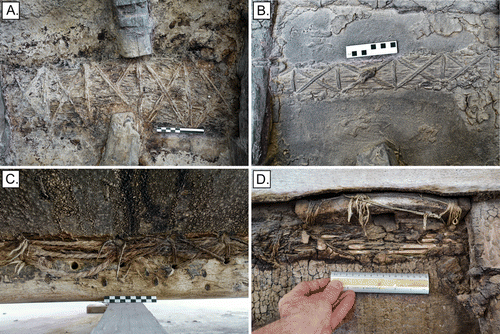
Stitching of the keel and posts
The intact nature of the QM vessels again made understanding of the stitching process around the keel and garboard strakes challenging. Outboard, the cross‐stitched cordage, running in a |X|X|X|X| pattern along the seam between keel and garboard strakes, is a familiar feature of the western Indian Ocean sewn‐boat tradition. The wadding beneath comprises a continuous run of a similar cordage looped back and forth along the length of the seam (Fig. 12C). What is striking, however, is the presence of the same cross‐stitch configuration—this time with grassy wadding beneath—overlaying the upper face of the keel inboard, crossing between the port and starboard strakes (Figs 12A and 13). This strongly suggests that both garboards were stitched into place at the same time, as part of a unified stitching sequence. We know of no parallel to this among other regional sewn boats, where normally each garboard is attached independently (cf Vosmer, Citation1997: 234, fig. 25). A hypothetical reconstruction of the sequence is shown in Figure 14. The process starts with a cord passed through one of the holes drilled horizontally through the keel such that the midpoint of the cord's length sits at the midpoint of the hole. The rope is then locked into place using a temporary peg, and the stitching proceeds with both ends of the rope active at the same time, the trajectory of each mirroring that of the other as they cross from port to starboard, and from garboard to keel.
Figure 13 Diagram representing the sewing pattern of the keel‐garboard assembly of the QM baggāras. (Image: Alessandro Ghidoni).

Figure 14 Hypothetical reconstruction of the sewing sequence of the keel‐garboard assembly of the QM baggāras. (Image: John P. Cooper).
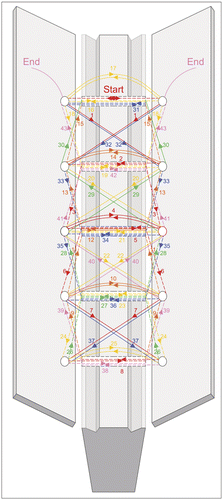
The stitching is run through holes of 10–14 mm diameter drilled horizontally through the keel between port and starboard, and through others drilled through the garboard strakes directly above the keel holes. The authors’ opportunistic sampling indicated that the keel holes—and hence the garboard stitching holes corresponding to them—are typically spaced 100–120 mm apart on baggāras 1 and 3, and 85–95 mm apart on baggāra 2. The distance of the holes in the keel and garboard strakes from the seam between these timbers can be inferred as approximately 25 mm on baggāras 1 and 2, and 35 mm on baggāra 3, based on measurement of intact stitches amidships. The holes in the strakes are plugged with wooden pegs following stitching to maintain the water‐tightness of the hull. Those drilled through the keel are not, since they do not impact water‐tightness.
The cordage comprising the outboard wadding of both baggāras 1 and 3 is two‐ply, Z‐laid, and with a coarse and reddish fibre suggestive of coir or date‐palm (Table ). The baggāra 1 cordage was narrower, however, at 6.5 mm diameter, compared to 10 mm on baggāra 3. On baggāra 2, in contrast, the two plies of the cord were S‐laid and comprised a coarse buff‐coloured fibre.Footnote8 This use of cordage alone as a wadding material is not reported in other regional ethnographic studies, although a number of authors report its use over a core of coir fibres (Varadarajan, Citation1998: 68; Kentley, Citation2003a: 150; Shaikh et al., Citation2011: 152–153; Shaikh, Citation2019: 382–383) and in several experimental reconstructions (Vosmer et al., Citation2011: 417; Ghidoni, Citation2019: 367, 369, 375; Staples and Blue, Citation2019: 319–322, 329).
The builders of the QM baggāras fastened the ‘false’ outer stem and stern posts—whether the latter was a dedicated post, or the first plank of the fashīn—using the same sewing technique as the keel‐garboard assemblage: a double‐strand cordage arranged in a IXIXIXI pattern over wadding made of ropes outboard, with the same IXIXIXI pattern over grass wadding inboard. The stem sewing is actually a continuation of that of the keel and garboards. At the stern, the post stitching is separate, since the keel‐garboard stitching continues aft to fasten the lower edge of the fashin.
Stitching of the hull planking
The stitching system used to edge‐join the planking of the baggāras—and indeed the kettuvallams discussed below—is reflective of the wider ‘single‐wadding’ tradition of the western Indian Ocean, its chief characteristic being the cross‐stitching over wadding inboard and vertical recesses for the stitching outboard (Fig. 15) (Yajima, Citation1976: 25–27; Prados, Citation1996: 101–103; Vosmer, Citation1997: 232; Chittick, Citation1980: 301–303). Similar approaches are taken in the Omani/Yemeni kambārī/sanbūq (Bowen, Citation1952: 209–212; Prados, Citation1996: 101–103; Vosmer, Citation1997: 231–234; Camelin, Citation2006: 105; Weismann et al., Citation2019) and Somali beden (Chittick, Citation1980: 301–303). This technique occurs on some of the 11th–15th century timbers found in al‐Balid in Oman (Belfioretti and Vosmer, Citation2010: 113; Pavan et al., Citation2018: 228; Vosmer, Citation2019: 308) as well as the 12th–15th century sewn timbers from Quseir al‐Qadim in Egypt (Blue, Citation2006: 280–282). It stands in contrast to the ‘double‐wadding’ approach adopted in earlier periods, whereby wadding is laid along both the inboard and outboard seams, and overstitched on both sides—for example on the Belitung and Phanom‐Surin ships (Flecker, Citation2000: 206; Citation2001: 339; Vosmer, Citation2019: 307) and at least some of the 11th and 12th century timbers from al‐Balid (Vosmer, Citation2017: 198–200; Citation2019: 308; Pavan et al., Citation2018: 228).
Figure 15 Diagram representing the pattern and sequence of the plank‐to‐plank sewing of the QM baggāras. (Image: Alessandro Ghidoni).

Grassy material is rarely noted as wadding in other works on regional sewn boats: Kentley (Citation1985: 307; Citation2003a: 140) does report the use of types of ‘marsh grass’ in masulas in India, and notes its propensity to rot more rapidly than coir, requiring the vessel to be re‐sewn every season. Other authors more commonly cite the use of loose coir fibres (Vosmer, Citation1997: 232; Fenwick, Citation2019: 387–388), as well as palm leaves (Bowen, Citation1952: 205; Prados, Citation1996: 102; Weismann et al., Citation2019: 355), unspecified local ‘plants’ (Chittick, Citation1980: 301, 303), a compound of pounded mangrove bark, coir, and strips of dried leaves of doum palm (Hyphaene thebaica) (Hornell, Citation1941: 61), and even ‘synthetic’ materials (Prados, Citation1996: 102). The kambārī in the OAAM collection has strips of an unidentified leaf as wadding on its keel‐garboard joint.Footnote9
For the most part, the inboard wadding on the hull seams of the QM baggāras comprises the same grassy material used in the inboard keel wadding. The only variation is in areas of repair, for example on baggāra 1, where a stiff, pale yellow, round‐stemmed reed‐like plant had been used, probably in a repair (Fig. 12D).
For the most part, the same cordage appeared in the stitching of the hull planking as on the keels, stems, and sternposts.
Lashings of frames and cheek pieces
The framing system of the baggāras consists of half‐frame pairs alternating with timber sets comprising a floor and two futtocks. All of these timbers are lashed into place using the same cordage as was used in sewing the planking. The timber in question is shaped by adze and set in place over the already sewn planking. The lashing positions are identified, and pairs of holes drilled through the hull planking on either side of the intended timber position. The lashing is passed through these holes and around the timber, and secured inboard with a knot on each moulded side (Fig. 16). Rebates are again cut into the outboard face of the planking in order to recess the cordage. The lower cheek pieces aft are also lashed. Each is fixed at four points: two connecting it to the fashīn and two to the hull planking (Fig. 17). Unlike on the framing timbers, the lashings pass through two holes in the planking/fashīn instead of four.
Figure 16 The frame lashing of the QM baggāras: A) view of a half‐frame inside the hull of baggāra 1; B) close‐up of a frame fastened by cordage threaded through holes in the planking of baggāra 3 and recessed in a rebate carved on the top side; C) the frame lashing pattern visible on the outside of the hull of baggarā 3, below the planking seam. (Images: John P. Cooper, Alessandro Ghidoni, Chiara Zazzaro).
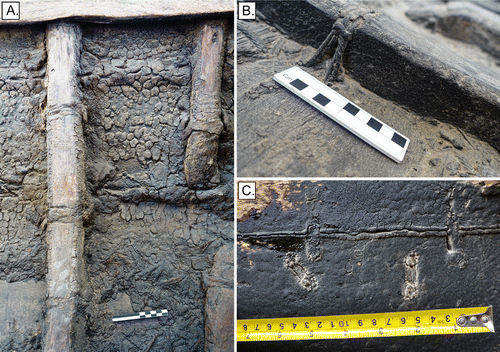
Stitching of through‐beams
Each baggāra has four through‐beams projecting through each side of hull. The two amidships are connected to each other by nailed carlings; the two others support the decks. All are sewn to the hull in an elaborate ‘six‐pointed’ sewing pattern that passes through six holes drilled in the planking and a 10–12 mm hole drilled vertically through the outboard section of the beam (Fig. 18A). Two of the planking holes are set directly above and below the beam hole, with the other four are in pairs aligned vertically on either side.
Figure 18 A) Outboard lashing of a through‐beam on baggāra 3; B) hypothetical reconstruction of the sewing sequence of the QM baggāra through‐beams based on Vosmer's reconstruction of the sewing of a beam on a battīl (2005: 179, fig. 4.2.5); C) the through‐beams at midships on a battīl, Muscat, Oman. Note the similarities with the baggarā through‐beams; D) through‐beam of the Jewel of Muscat reconstruction, based on the 9th‐century Belitung wreck. (Images: Chiara Zazzaro, Alessandro Ghidoni).
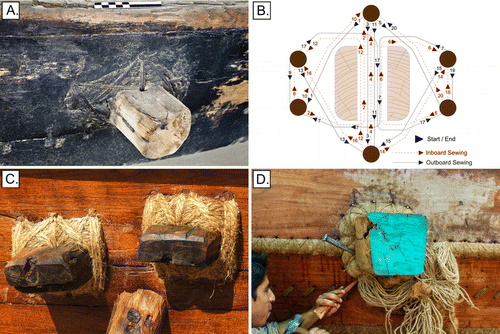
The beams are sewn with cordage that is similar—but thicker—to that used in the plank‐to‐plank stitching. Outboard, the stitching is mostly over wadding; inboard, the joint is partially covered by a clamp coated with a thick layer of bitumen and fish oil, making it difficult to determine whether there is also wadding inside—there is none on the similar Omani battīls, and was none on the Belitung wreck.Footnote10 The outboard wadding comprises various materials: mostly thick cordage, but also loose fibres (perhaps coir or date‐palm), grass, and cotton rags—the latter perhaps as a repair (Fig. 19). The thicker, more open, cordage points to an inferior quality. The wadding cordage is typically arranged in two looped bundles of approximately 10–15 ropes each, placed above and below the beam end. This can best be seen on the two midships beams on the port side of baggāra 1, where the returns of the ropes are visible (Fig. 18A).
Figure 19 Wadding materials in the through‐beam lashings of the QM baggāras: A) thick fibre ropes; B) grass wadding on baggāra 2; C) cotton rag around two of the through‐beams of baggāra 1 (Images: Chiara Zazzaro).
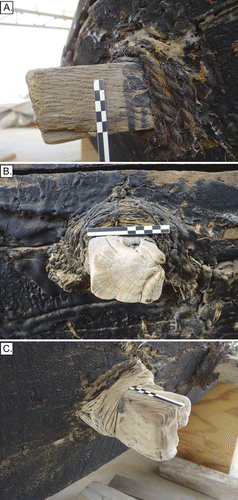
The beam stitching of the QM baggāras is almost identical to that of the battīls of the Musandam peninsula, Oman (Vosmer, Citation1997: 224, 227, fig. 13) (Fig. 18C). The only difference is that the six holes on the battīl are arranged in two horizontal rows of three above and below the beam because the beams are set too close together to place holes to the sides. The beam fastenings also resemble those of the Belitung shipwreck (Flecker, Citation2000: 207), albeit less elaborate and on a smaller scale (Fig. 18D).
Dowels
The use of wooden dowels (Table ) is, as already indicated, closely connected to the process of continuous stitching. They are used to align and fix the garboard strakes to the keel (Fig. 9A), hull planks to hull planks along both edge and scarf joints (Fig. 20A), to edge‐join the fashīn planking (Fig. 20B) and fix the ‘false’ stem and prow timbers (Fig. 20C). They are also used in the scarf joints of the gunwale timbers, even though these are otherwise nailed in place.
Iron fixings
There is a clear correlation on all three baggāras between the use of iron nails and their location with reference to the waterline. Their deployment only where contact with water is minimal implies something about the builders’ attitude towards the suitability of nails for joints that are extensively immersed. This is best seen in the cheekpieces. In all vessels, the lower aft cheekpieces are lashed to the hull, while the upper cheekpieces—forward and aft—are nailed. Likewise, the gunwales, the inwales set above the fore and quarter decks, as well as the deck planking itself, are nailed in place: again, all of these are far above the waterline.
Bitumen‐based coatings
The baggāras are covered extensively, both inboard and out, with a thick, black coating of varying consistency that the authors interpret as compounds of bitumen, a naturally occurring, highly viscous hydrocarbon (Fig. 21). It coats most of the planking, stitching, and wadding, waterproofing and protecting them from biological attack and physical damage. It is entirely absent from the through‐beams, gunwales, deck planks, and (on baggāras 1 and 3) the upper cheek pieces, and it is less apparent in the bilges, either because it was never put there or because it has rubbed away. More recently, the hulls have been treated with fish oil.
Figure 21 Bituminous coatings on QM baggāra 1: A) highly adulterated and friable bituminous coating on the inboard planking and stitching; B) purer and strongly adhered bitumen on the outboard planking (L) and fashīn (R). (Images: Chiara Zazzaro).
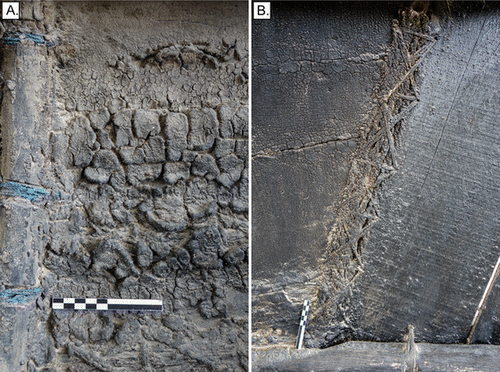
Although no chemical analysis has been done, the bitumen coating appears more adulterated inboard than outboard. Inboard, it is generally thicker, particularly on the sides, where it is prone to desiccation cracks around tessellations that crumble easily (Fig. 21A). Outboard, the coating appears generally less adulterated—to the extent, sometimes, of appearing shiny (Fig. 21B). Where it has been applied more thickly, it has a tendency to show signs of running due to heat, particularly on the sides of the hull; where desiccation cracks form, the resultant tessellations tend to remain strongly adhered.
This difference in the bitumen appearance inboard and outboard might be explained by deliberate choices in the mixing of the bitumen for each area. It might be the case that more adulterated mixes of bitumen were applied inboard to reduce melt and stickiness, while less adulterated bitumen was applied outboard to enhance its waterproofing qualities. However, it might equally be incidental: the smooth outboard surfaces of the hull make it easier to apply the bitumen and obtain an even coating, whereas the presence of frames, cordage, wadding, and other elements make this more difficult inboard, perhaps resulting in a less‐polished layer. Moreover, the outboard bitumen is continuously washed by seawater, while on the inside it is regularly covered by fish, matting, nets, fish oil, and other substances, making it progressively more adulterated over time. The interior of the hull is also the most exposed to the sun, which can cause the bitumen to become warm, plastic, and more likely to mix with other substances than on the outside, where the water cools it.
Archaeological bitumen fragments interpreted as coming from boats at the late‐6th‐millennium BCE site of As‐Sabiyah (![]() ) and mid‐3rd‐millennium Ra's al‐Jinz (
) and mid‐3rd‐millennium Ra's al‐Jinz (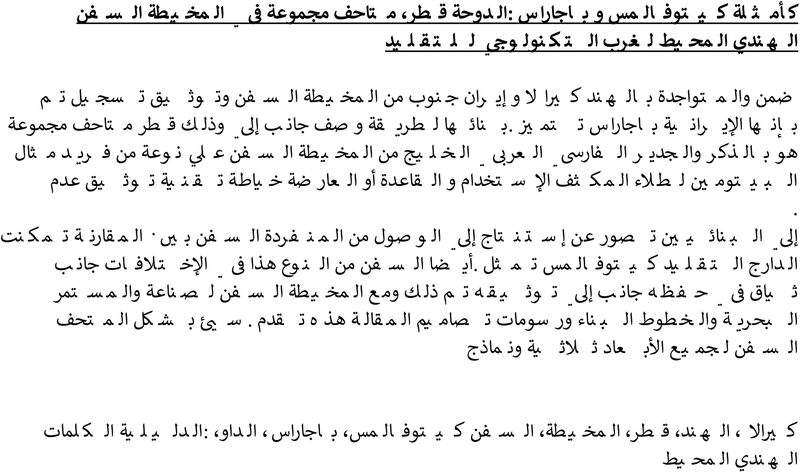 ) sites suggest that boatbuilders in the distant past actively created bitumen compounds (Connan et al., Citation2005: 55). Materials such as sand, dust, or crushed vegetal matter might have been added to the heated bitumen before application in order to make it easier to handle or go further, as well as being more resistant to melting, running, and abrasion following application.
) sites suggest that boatbuilders in the distant past actively created bitumen compounds (Connan et al., Citation2005: 55). Materials such as sand, dust, or crushed vegetal matter might have been added to the heated bitumen before application in order to make it easier to handle or go further, as well as being more resistant to melting, running, and abrasion following application.
Investigation into, indeed awareness of, the use of bitumen as a protective coating among plank‐built vessels of the western Indian Ocean has generally been limited (contra Burger et al., Citation2010: 384): more familiar is the white compound of lime and tallow—known in eastern Arabian Arabic as chunam (al‐Salimi and Staples, Citation2019: 223), and in western Arabian Arabic as shaham (Agius et al., Citation2014: 155–156)—used for anti‐fouling the exterior of the hull below the waterline, and a compound of shark‐liver oil and resin for the upper parts (Hawkins, Citation1977: 38, 73; Hornell, Citation1942: 12; Vosmer, Citation1997: 203–204; Agius, Citation2002: 153; Agius et al., Citation2014: 155–156). This is not to say that bitumen coatings are unknown in the wider region and broader chronology. Until recently, boatbuilders on the rivers and marshes of Iraq used it extensively on both reed‐bundle and plank‐built craft (Thesiger, Citation1954: 277; Ochsenschlager, Citation1992: 49–53, 62; Citation2004; McGrail, Citation2001: 64–67). Moreover, archaeological and textual evidence show its use in waterproofing reed‐bundle and (to a lesser extent) plank‐built boats in ancient Mesopotamia, the Gulf, and Oman (Cleuziou and Tosi, Citation1994; Citation2000; Connan et al., Citation2005; Carter, Citation2006; Citation2008: 97–101; Citation2012: passim; Agius, Citation2008: 113; Badel and Kramm, Citation2014).Footnote11 Blue (Citation2006: 281) also found a material on both sides of the Quseir sewn planks that she interpreted as bitumen or pitch. Meanwhile iconographic representations of black hulls in the Maqāmat of al‐Hariri (Bibliothèque Nationale, Ms Arabe 6094, fol. 68, in Agius, Citation2008: 152) and a number of Persian miniatures (Eastman, Citation1950: 156, plate XII) may reflect—though certainly do not prove—the past use of bitumen as a hull coating. Despite this breadth of evidence, the QM baggāras are the only surviving seagoing vessels with bitumen coating in the western Indian Ocean known to the authors.
The use of bitumen is not inevitably associated with sewn construction. Bowen (Citation1952: 212), Prados (Citation1996: 105) and Weismann (Citation2019: 348) all note fish oil on the MFL kambārī, while two of the present authors (Cooper and Zazzaro) observed lime mix on the remnants of a sewn sanbūq/kambārī encountered in Aden in 2008.Footnote12 Indeed, the use of lime‐tallow mix is a practice of long standing on sewn vessels, with traces of lime compound found as luting on the 8th‐century‐CE Phanom‐Surin and 9th‐century‐CE Belitung wrecks in Thailand and Indonesia, respectively (Flecker, Citation2000: 203, 204; Guy, Citation2017: 192; Vosmer, Citation2019: 310). Experimental sewn‐boat projects such as the Sohar and Jewel of Muscat have also deployed these coatings rather than bitumen (Severin, Citation1982: 68; Citation1985: 283; Vosmer et al., Citation2011: 216; Vosmer, Citation2019: 309, 422)—although Severin (Citation1985: 281) opted for coconut oil rather than shark‐liver oil.
Luting
The intact state of the QM baggāras means that the presence and nature of any luting applied to the faying surfaces of the hull planking cannot easily be established. It certainly would be expected: the seams of sewn hulls must be made watertight before they are covered over by wadding and stitching (Vosmer et al., Citation2011: 6; Ghidoni, Citation2019: 369; Shaikh, Citation2019: 380–84; Vosmer, Citation2019: 310; Weismann et al., Citation2019: 351). Vosmer (Citation2019: 310) reports that the process often involves ‘coating each faying surface of the planks to be joined with a luting substance, and sandwiching a piece of cloth […] between the planks’. He adds that this ‘luting substance’ is usually resin or bitumen, perhaps mixed with fish or coconut oil, although on the Belitung and Phanom‐Surin ships it seems to have been lime putty (Vosmer et al., Citation2011: 6). Belfioretti and Vosmer (Citation2010: 113) also noted traces of luting on some of the sewn ship‐timbers found at al‐Balīd in Oman (Pavan et al., Citation2018: 228). Meanwhile, Chittick (Citation1980: 301) refers to the Somali builders of sewn beden using ‘pitch (obtained commercially)’ as luting. Given the abundance of bitumen found on the QM baggāras, it might be surprising if this was not also the substance used for the luting.
Propulsion and steering
The presence of large square holes set along the gunwales of the QM baggāras, with brackets sewn into the planking directly below them, indicate housings for thole pins, and hence that the baggāras were rowed. Baggāras 1 and 3 have two such holes per side, indicating two rowing positions. In contrast, baggāra 2 has four holes per side, although two are too close together for them to be two simultaneous rowing positions: hence there are probably three at any one time (Figs 11–3). The vessels were acquired without oars.
Two obliquely set carlings connecting the two main through‐beams on each of the baggāras (Figs 11–3) suggest supports for a mast, even though there is no evidence of a mast step, which would have been essential on a vessel with delicate stitching and grassy wadding on the upper face of its keel. The same configuration of carlings also occurs on the nailed Emirati baggāra (‘baqqārah’; Weismann et al., Citation2014: 421), as well as on the nailed Dubai shāhūf in the Deutsches Museum, Munich, and the nailed Omani ‘zarooqa’ (Weismann et al., Citation2014: 422; Vosmer, Citation1997: 227): the last two of these have a mast step set below the carlings. Vosmer interprets the zarooqa configuration as vestigial of a time when that vessel, now exclusively rowed, was sailed. The same might be true of the QM baggāras.Footnote13
The QM baggāras had no rudder, nor indeed any apparent fittings for one. The construction drawings of the very similar (but nailed) Emirati baggāra in Weismann et al. (Citation2014: 421) depicts a medial rudder secured onto the fashīn by ropes passed through holes in the rear plank of the fashīn, and guided into place by aft extensions to the two fashīn cheekpieces. However, the requisite holes are absent on the fashīns of the QM baggāras, and the cheekpiece extensions appear too close together to have accommodated a rudder: this suggests that the baggāras were steered with their sweeps alone.
The kettuvallams
We now turn our attention to the construction sequence and features of the other sewn‐boat type in the QM collection—the kettuvallams. Unlike the defunct baggāra, construction of the kettuvallam can still be observed in Kerala today: the following observations, made out of context in the QM boatyard, would certainly be enriched by direct observation at their place of making. For now, they must suffice.
Keralite kettuvallam construction
Owing to time limitations, the authors surveyed only one of QM's two kettuvallams; both are similar to each other in form, construction, and state of preservation (Figs 4 and 6B). Each is double‐ended, relatively flat‐bottomed, and of a much slenderer length‐to‐beam ratio than the baggāras. Both bow and stern curve sharply upwards. The vessels have no keel or deck, and are predominantly fastened with cordage using the single‐wadding method on the planking, with some use of nails; no dowels are apparent. The only direct evidence of means of propulsion are oar rests and rope rowlocks. An internet search of images of the same type of vessel suggests it is propelled exclusively by oars, and steered using a dedicated steering oar. This is also suggested by the positioning of the thwarts, which indicate rowing positions.
The inferred construction sequence of the kettuvallam is as follows:
Central strake and posts
Construction begins around a central strake comprising a single plank of the same thickness and width as the other full‐length planking. This is edge‐joined to the adjacent planks by means of the same continuous stitching method used for subsequent planks (see below). The ends of the central strake are butted and sewn to the posts, which curve upwards before straightening to an angle of around 42°. The planks are sewn with wadding inboard only, with occasional use of guide nails (see below). There is no visible evidence of the rabbeting of the hood‐ends into the posts; a white putty‐like substance is noticeable in some small areas in the sewing of the outer post to the planks (Fig. 22).
Figure 22 A white putty‐like substance within the stitching fastening the outer post to the planking of kettuvallam B. (Image: Chiara Zazzaro).
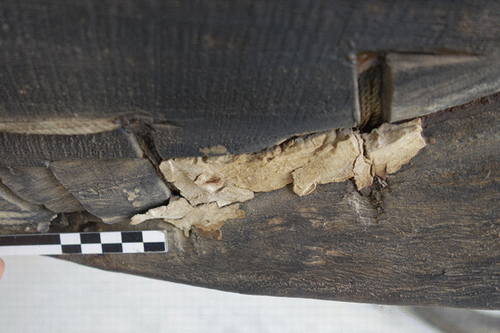
The posts are capped with decoratively carved finials that are sewn and nailed to the posts. At the bow, this consists of a single large scroll enfolding a carved fish figure, while at the stern it comprises a more abstract form (Fig. 23A, B).
Figure 23 Decorative carved finials sewn to the posts of kettuvallam B. (Images: Alessandro Ghidoni, Chiara Zazzaro).
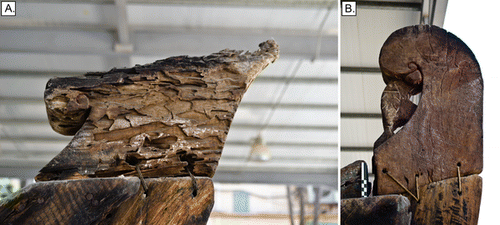
Outboard, the stem and stern posts each have a painter hole; that of the stern was also used to secure the steering oar (Fig. 24). Two short timbers nailed to either side probably aimed at reinforcing the posts around these holes.
Planking
The hull planking proceeds upwards from the central ‘keel’ plank. On both sides, the hull has five full‐length strakes running from stem to stern, the planks of all being butted and sewn together with internal wadding, with some nails (see below). After the third plank, there is a noticeable chine, after which the hull sides rise almost vertically; there are two drop‐strakes at the turn, which taper forward and aft. Since the sheer line rises sharply at both ends, two or more addition planks are introduced and fastened by nails and screws (Fig. 4), the lowest of these extension planks is also sewn to the sheer plank. The hood‐ends of all strakes that run the length of the hull—that is up to the fourth strake—are both stitched and nailed; higher up, they are nailed only (Fig. 25).
Figure 25 The nailed and screwed hood‐ends above the fourth strake of kettuvallam B. (Image: Chiara Zazzaro).
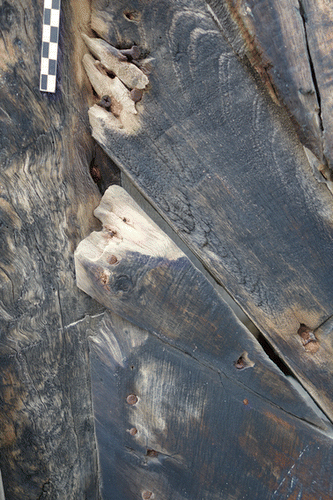
The planking is 40–45 mm thick and of unknown species; a straight and parallel kerf of variable spacing again suggests the use of a band saw, as with the baggāras. Tool marks on the visible edges of the planking suggest the use of an adze or chisel.
The overall uniformity and symmetry of the planking again suggests a well‐established system of construction, as well as readily availability materials. It perhaps also suggests a vessel that is not too old, since instances of repair seem limited to cracks forming in individual timbers (Fig. 26). There is no visible evidence to indicate how the curvature of the planks was achieved.
Figure 26 A rubbing strake nailed and lashed to the outer face of the sheer strake of kettuvallam B. (Image: Chiara Zazzaro).
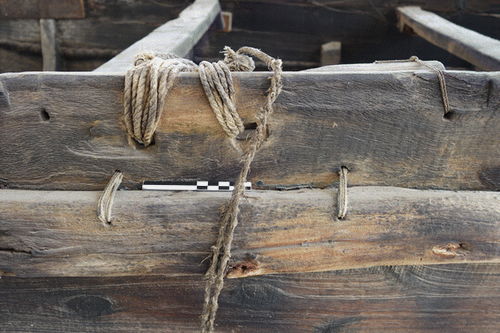
A rubbing strake is nailed and lashed to the outer face of the sheer strake (Fig. 27). On the forward half of the hull, a washstrake is loosely lashed to the sheer strake; aft of it a gunwale is attached.
Framing sequence
The kettuvallam has 11 sets of frames, each comprising a floor and two futtocks made of naturally curved timbers of unknown species, probably sourced locally (that is, in Kerala). Parallel saw marks are apparent on their moulded faces; these would have been shaped by bandsaw. Each futtock is obliquely butt‐jointed to its floor‐timber. The framing timbers are joined to the planking by means of widely spaced lashings (see below). Each floor has linear recesses of triangular cross‐section on its lower sided face to accommodate the planking stitching and wadding, with one functioning as a limber hole. The floor‐timbers do not, generally, extend beyond the seam of the third strake. Hence, as with the baggāras, they might have been attached at this stage in order to brace the hull in its achieved shape, before the side planking was added. However, Ransley's observations (Citation2009: 2.106) of the construction of a somewhat different kettuvallam in Munruthuruthu, Kerala, suggest that these are added after all the strakes have been built up, along with the other frames.
Beams and thwarts
The kettuvallam has seven cross‐timbers: five forward and two aft. Those furthest forward and furthest aft are essentially thwarts that are fitted directly to the hull's (nailed) upper strakes, one is recessed above to leave space for the rivet. The other five, although also acting as rowing positions, function structurally as beams. They are accommodated into recesses cut into the penultimate planks and rivetted into it at each end. These beams are recessed below to leave space for the rivet. The rust of the latter suggests it is ferrous: the outboard rubbing strake concealed any evidence of roves. The extension strakes are also recessed to take these timbers. The four beams forward all have rowing positions associated with them, with the forward two of these having only one rowing position each, due to the narrowing of the hull—although one has two thole‐pin holes on the same (port) side.
Coating and luting
Throughout the vessel, a dark, oily substance is found inboard and outboard along the seams, although it was worn away to bare wood in many places. Interpreted as a preservative coating, this might be cashew or kadu (pumpkin seed) oil (Shaikh, Citation2019: 380, 382), or otherwise resin (chundruz, khundrus; Severin, Citation1985: 285; Shaikh, Citation2019: 380).
The putty‐like substance found occasionally in the seams, resembling chunam, could be luting.
Fastenings
As with the baggāras, the fastenings of the kettuvallam are particularly interesting because they combine a variety of techniques, such as sewing, lashing, nailing, screwing, and riveting.
Plank sewing
The hull planks are edge‐joined using continuous stitching over inboard wadding, in a way identical to that used for the baggāras (Fig. 28). Small sections of sewing also fix the top edge of the sheer strake to the lower edge of the extension planks at bow and stern. The sewing cordage comprises a single, thin, three‐yarn, S‐twisted rope, threaded through holes spaced around 60–70 mm apart and set 20 mm from the seam. The cordage appears to be cotton. The wadding is made from a fine fishing net of about 5 mm gauge (Fig. 28A): unlike on the baggāras, it is never found outboard. The cordage and wadding materials suggest that the boat was re‐sewn relatively recently, using readily available and cheaper materials than the traditional coir.
Plank nailing
The kettuvallam’s builders used nails to edge‐fasten the planks to facilitate sewing, in a manner analogous to the dowels of the baggāras. These are driven obliquely from outboard near the edge, passing through the butted faces of the adjacent planks, at intervals of around 1 m—much further apart than the baggāra dowels (Fig. 2929A–B). Their heads are recessed into triangular notches.
Figure 29 Metal fastenings used in the construction of kettuvallam B: A) nails driven square and obliquely secure the hood‐ends of the extension planks to the stern post; B) close‐up of one of the oblique nails edge‐fastening the hull planks; C) the large rivet fixing the thwart to the hull planking and rubbing strake. (Images: Alessandro Ghidoni, Chiara Zazzaro).
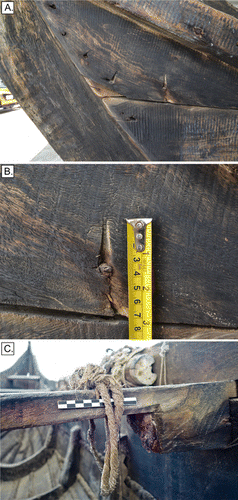
Hybrid fastening: nailing and sewing
The kettuvallam builders used a combination of sewing and nails to join the hood‐ends of planks to the posts up as far as the sheer strake. The short extension strakes above that level at the bow and stern are nailed, and sometimes screwed, to their respective posts, but not stitched: the nails are driven either square or obliquely and recessed. The washstrake is fastened to the sheer plank using both obliquely driven nails and sewing (Fig. 3030A–B). The sewing pattern here resembles that of the hull planking, but with much larger stitches (>300 mm) and no wadding: the same type of stitching also secures the rubbing strake aft (Fig. 30A). The greater hole spacing and lack of wadding makes for weak fastening between these elements—the builders did not require a strong bond or water‐tightness here. This sewing method, also observed in the southeast Indian masula (Kentley, Citation2003a: 158), also secures the kettuvallam’s finials (Fig. 23).
Frame lashings
The frames of the kettuvallam are lashed to the hull; unlike the baggāras, the cordage passes through a hole drilled through the frame, instead of turning around it (Fig. 31A). The corresponding holes on the hull planks are arranged horizontally, one on each side of the frame (Fig. 31B). These lashings are often obliquely angled—sometimes considerably—instead of being square to the hull planking as was the case with the baggāras. In a few cases, the futtocks, or part of a floor‐timber, are lashed continuously; essentially, the cordage was not cut after each lashing, but run to the next one, though not under tension.
Figure 31 Frame lashings inboard on kettuvallam B, showing the cordage passing through holes drilled through the moulded face of the frames; A) the lashing cordage of the frame in the foreground is continuously threaded through each hole; B) the frame lashing outboard, highlighted in red. (Images: Chiara Zazzaro).
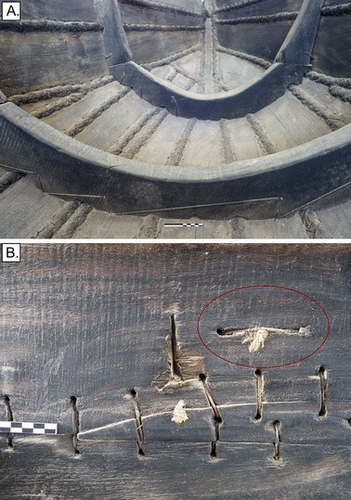
Discussion and conclusion
The sewn baggāras and kettuvallams of the QM collection are unique museum holdings of western Indian Ocean sewn‐boat technologies. The former are extremely rare survivals of a type that is, as far as we are aware, no longer in use anywhere; while the kettuvallams are still in use in Kerala, they are not, to our knowledge, preserved in museum contexts elsewhere.
The baggāras are exceptional not only for their rarity, but also because of two particular characteristics: one is the previously undocumented technique—academically at least—of sewing both of the garboard strakes to the keel at the same time, in a single sewing action, using a single piece of cordage that crosses back and forth from port to starboard. We have hypothesized a sequence for the stitching of this joint. The other is their extensive use of bitumen as a coating, both inboard and outboard, something that has hardly been noted in the modern‐era boatbuilding traditions of the western Indian Ocean.
The fact that QM has acquired five examples of the baggāra allows an opportunity for comparison between individual vessels that point to the inherence of variation among vernacular watercraft, even as the builder conceives of and works towards an overall type‐form. The vessels do not vary greatly from each other in principal dimensions and ratios (Table ): keel and post assemblies are broadly similar; the builders’ conceptions (though not execution) of overall planking objectives are similar; beam and deck configurations are almost identical; approaches to stitching, lashing, and the use of iron fastenings are consistent.
And yet there is plenty evidence of the hand of the individual builder in each vessel—hinting at different builders across the set. The builder of Baggāra 3 appears to have had the available planks and skills to keep closest to concept, achieving a high degree of uniformity and symmetry in the hull schema. The resulting form is ‘full’ in cross‐section, with a flat garboard amidships. Its bow rakes some 3–4˚ more than the other vessels. The builder of Baggāra 1, meanwhile, showed a willingness, within the overall concept, to use joggle jointing not seen on the other vessels; the hull is less full in cross‐section, with an acutely set garboard. Finally, Baggāra 2 stands out on several fronts: its main keel timber is proportionally longer; its aft keel timber is ‘flatter’; and it is relatively flatter bottomed than the other two. In terms of its planking plan, the deployment of a ‘double‐width’ plank on the port site and the plethora of stealers and graving pieces might be the result of later repair, but they certainly indicate a willingness to adapt available materials to achieving the overall hull concept. Across the hulls, there is also some variety in the cordage and dowels used as fastenings, as Tables and show.
The kettuvallams are a variety of ‘tied’ boat that is still in use in Kerala but that has not previously been described in detail. Only one of the two vessels in the QM has been presented here. Naval‐lines and construction drawings show a rather symmetrical, U‐shaped hull with a highly regular planking pattern. Sewing techniques are highly regular and consistent along the seams, suggesting that the boat is not very old or was not used much. Meanwhile, the vessel shows compelling similarities with the sewing techniques found in ancient sewn boats, thereby providing an important ethnoarchaeological reference point.
Supporting Information
Additional supporting information may be found online in the Supporting Information section at the end of the article.
1. 3D Photogrammetry model of baggāra 1.
2. 3D Photogrammetry model of baggāra 2.
3. 3D Photogrammetry model of baggāra 3.
4. 3D Photogrammetry model of kettuvallam B.
The research data supporting this publication are openly available from Zenodo, doi: 10.5281/zenodo.3939127
rjna_a_12127362_sm0001.pdf
Download PDF (3.5 MB)rjna_a_12127362_sm0002.pdf
Download PDF (83.9 MB)rjna_a_12127362_sm0003.pdf
Download PDF (21.5 MB)rjna_a_12127362_sm0004.pdf
Download PDF (1 MB)Acknowledgements
The authors thank QM for enabling this research, in particular, H.E. Sheikha Mayassa bin Hamad Al Thani, Chairperson, Sheikh Fahad Al Thani, Director of the Chairperson's Office, and Ahmad Musa al‐Naimi, CEO. We also thank QM's Ebrahim Saleh Al Khulaifi, Abdullah Faisal Al Kubaisi, Reda Musa al‐Hajj, and Abdulrazack Abdulqader. Thanks are also due to University College London‐Qatar (UCL‐Q), the Institute of Arab & Islamic Studies of the University of Exeter, and the University of Naples ‘l'Orientale’ for their financial support for the research. We are particularly grateful to Professor Rob Carter for instigating the conversation that gave rise to this research, and for setting up the visit itself.
Notes
1 Formerly Agisoft Photoscan Pro.
2 No. 484, Acc. No. 1984, Location 46 G2, As 88.
3 Also referred to as ‘batting’ (cf Prados, Citation1996: 102) or ‘padding’ (cf Varadarajan, Citation1998: 61).
4 Only one of QM's kettuvallams, which we label kettuvallam B, is reported here: the two vessels are very alike.
5 A lack of data led Prins (Citation1986: 100–110) to overlook this broad South Asian‐Arabia distinction (Fenwick, Citation2015: 393).
6 Precisely 63% of total keel length in baggāra 1; 68% in 2; 66% in 3.
7 As part of the British Academy‐funded The Boat Builders of Zanzibar: Nautical Technology and Maritime Identity in a Changing World project (Project SL‐08385; 2018–19; P.I. John P. Cooper; Co.I. Lucy Blue; participant researcher Alessandro Ghidoni).
8 The colour difference might simply be a result of variable staining from the bituminous coating of the vessels.
9 We thank our anonymous peer reviewer for this observation.
10 Again, we thank our anonymous peer reviewer for these observations.
11 A sample of bitumen was also found ‘in a sample of hard material adhering to a thwart beam’ on the Belitung wreck (Burger et al., Citation2010: 384), but this has not been published in detail.
12 Direct observations, made during fieldwork as part of the University of Exeter's MARES Project (2008–2012), led by Professor Dionisius A. Agius and funded by the Golden Web Foundation. Cooper also observed this boat with Dr Lucy Blue during their 2007 Yemen fieldwork as part of the University of Southampton's Indian Ocean Hūrī project.
13 Although, as our anonymous reviewer kindly suggests, it may always have been no more than a stylistic reference to larger, sailed vessels.
References
- Adams, R.M., 1985, Designed flexibility in a sewn boat of the western Indian Ocean, in S. Mcgrail and E. Kentley (eds), Sewn Plank Boats: Archaeological and Ethnographic Papers Based on those Presented to a Conference at Greenwich in November, 1984, 289–302. Greenwich and Oxford.
- Agius, D.A., 2002, In the Wake of the Dhow: The Arabian Gulf and Oman. Reading.
- Agius, D.A., 2008, Classic Ships of Islam: From Mesopotamia to the Indian Ocean. Leiden and Boston.
- Agius, D.A., Cooper, J.P. and Zazzaro, C., 2014, The maritime heritage of Yemen: A focus on traditional wooden ‘dhows’, in D.A. Agius, T. Gambin and A. Trakadas (eds) Cultural Heritage and Ethnography of the Mediterranean and the Red Sea, 143–158. Oxford.
- Agius, D.A., Cooper, J.P., Zazzaro, C., Semaan, L. and Carter, R., 2016, Remembering the Sea: Personal and Communal Recollections of Maritime Life in Jizan and the Farasan Islands, Saudi Arabia. Journal of Maritime Archaeology 11.2, 127–177.
- Badel, É. and Kramm, U., 2014, Mineralogical investigations of Ras al Jinz 2 bitumen (Jaʿalān, Sultanate of Oman). Proceedings of the Seminar for Arabian Studies 44, 25–34.
- Belfioretti and Vosmer, T., 2010, Al‐Balīd Ship Timbers: Preliminary Overview and Comparisons. Proceedings of the Seminar for Arabian Studies 40, 111–118.
- Blue, L.K., 2006, Sewn boat timbers from the medieval Islamic port of Quseir al‐Qadim on the Red Sea coast of Egypt, in L.K. Blue, F. Hocker and A. Englert (eds), Connected by the Sea: Proceedings of the Tenth International Symposium on Boat and Ship Archaeology, Denmark 2003, 277–283. Oxford.
- Bowen, R.L.B., 1952, Primitive Watercraft of Arabia. The American Neptune 12, 186–221.
- Burger, P., Charrié‐duhaut, A., Connan, J., Albrecht P. and Flecker, M., 2010, The 9th‐Century‐AD Belitung Wreck, Indonesia: analysis of a resin lump. IJNA 39.2, 383–386.
- Burningham, N., 2019, On the Flexibility of Indian Ocean Sewn‐Plank Vessels: the structural performance of Jewel of Muscat. IJNA 48.2, 335–341.
- Camelin, S., 2006, Les Pêcheurs du Yémen: organisation et transformation d'une communauté de pêcheurs de la côte de l'océan Indien. Paris.
- Carter, R., 2002, Ubaid‐period boat remains from As‐Sabiyah: excavations by the British Archaeological Expedition to Kuwait. Proceedings of the Seminar for Arabian Studies 32, 13–30.
- Carter, R., 2006, Boat remains and maritime trade in the Persian Gulf during the sixth and fifth millennia BC. Antiquity 80.307, 52–63.
- Carter, R., 2008, Excavations and Ubaid‐Period Boat Remains at H3, As‐Sabiyah (Kuwait), in E. Olijdam and R.H. Spoor (eds), Intercultural Relations between South and Southwest Asia: Studies in commemoration of E.C.L. During Caspers (1934–1996), 92–102. Oxford:BAR International Series 1826.
- Carter, R.A., 2012, Watercraft, in D.T. Potts (ed.), A Companion to the Archaeology of the Ancient Near East, Volume 1, 347–372. Oxford.
- Chittick, N., 1980, Sewn Boats in the Western Indian Ocean, and a Survival in Somalia. IJNA 9.4, 297–309.
- Cleuziou, S. and Tosi, M., 1994, Black Boats of Magan. Some Thoughts on Bronze‐Age Water Transport in Oman and beyond from the Impressed Bitumen Slabs of Ra's al‐Junayz, in A. Parpola and P. Koskikallio (eds), South Asian Archaeology, Helsinki 1993, 745–761. Helsinki.
- Cleuziou, S. and Tosi, M., 2000, Raʾs al‐Jinz and the Prehistoric Coastal Cultures of the Jaʿalān. Journal of Oman Studies 11, 19–73.
- Connan J., Carter, R.A., Crawford, H.R., Tobey, M., Charrié‐duhaut, A., Jarvie, D., Albrecht, P. and Norman, K., 2005, A comparative geochemical study of bituminous boat remains from H3, As‐Sabiyah (Kuwait), and RJ‐2, Ra's al‐Jinz (Oman). Arabian Archaeology and Epigraphy 16, 21–66.
- Dixon, C., 2019, Models as Evidence for Sewn‐boat Traditions. IJNA 48.2, 286–301.
- Eastman, A.C., 1950, On Three Persian ‘Marine’ Paintings. Journal of Near Eastern Studies, 9.3, 153–163.
- Edye, J., 1834. Description of the various Classes of Vessels constructed and employed by the Natives of the Coasts of Coromandel, Malabar and the Island of Ceylon, for the Coasting Navigation. The Journal of the Royal Anthropological Institute of Great Britain and Ireland 1.1, 1–14.
- Facey, W., 1979, Oman: A Seafaring Nation. Muscat.
- Facey, W., 1987, The Boat Carvings at Jabal al‐Jussiyah, Northeast Qatar. Proceedings of the Seminar for Arabian Studies 17, 199–222.
- Fenwick, V., 2015, A Cognitive Approach to Extant Boat Structure in Goa, India. IJNA 44.2, 388–409.
- Fenwick, V., 2019, Picking up the Pieces: Goa's endangered traditional craft. IJNA 48.2, 387–399.
- Fiorillo, F., Limongiello, M. and Jiménez fernández‐palacios, B., 2016, Testing GoPro for 3D model reconstruction in narrow spaces. ACTA IMEKO 5.2, 64–70.
- First Regional Office of Fine Arts, 2016, Study of the Phanom‐Surin Shipwreck. Ratchaburi.
- Flecker, M., 2000, A 9th‐century Arab or Indian shipwreck in Indonesian waters. IJNA 29.2, 199–217.
- Flecker, M., 2001, A ninth‐century AD Arab or Indian shipwreck in Indonesia: first evidence for direct trade with China. World Archaeology 32.3, 335–354.
- Flecker, M., 2011, A Ninth‐Century Arab Shipwreck in Indonesia: The First Archaeological Evidence of Direct Trade with China, in R. Krahl, J. Guy, J.K. Wilson and J. Raby (eds), Shipwrecked: Tang treasures and monsoon winds, 100–119. Washington, DC.
- Ghidoni, A., 2019, Building Pâris’ Beden Seyad: a replica of the Omani 19th‐century sewn fishing vessel. IJNA 48.2, 360–376.
- Greeshmalatha, A.P., 2013, Different Styles and Designs of Kerala Vessels, in K.N. Ganesh (ed.), Exercises in Modern Kerala History, 32–49. Kottayam.
- Gundert, 2013 (1st edn 1872), Malayalam‐English Dictionary. Kottayam.
- Guy, J., 2017, The Phanom Surin Shipwreck, a Pahlavi Inscription, and their Significance for the History of Early Lower Central Thailand. Journal of the Siam Society 105, 179–196.
- Hassiba, R., Cieslinski, G.B., Chance, B., Al‐naimi, F.A., Pilant, M. and Rowe, M.W., 2012, Determining the age of Qatari Jabal Jassasiyah Petroglyphs. QScience Connect 44, 1–16.
- Hawkins, C.W., 1977, The Dhow: an illustrated history of the dhow and its world. Lymington.
- Al‐hijji, Y., 2001, The Art of Dhow‐Building in Kuwait. London.
- Hornell, J., 1920, The Origins and Ethnological Significance of Indian Boat Designs. Calcutta.
- Hornell, J., 1941, The Sea‐Going Mtepe and Dáu of the Lamu Archipelago. The Mariner's Mirror 27.1, 54–68.
- Hornell, J., 1942, A Tentative Classification of Arab Sea‐craft. The Mariner's Mirror 28.1, 11–40.
- Hornell, J., 1946, The Sailing Craft of Western India. The Mariner's Mirror 32.4, 195–217.
- Hourani, G.F., 1995 (1st edn 1951), Arab Seafaring. Princeton.
- Howarth, D., 1977, Dhows. London.
- Jansen van rensburg, J., 2016, The Maritime Traditions of the Fishermen of Socotra, Yemen. Oxford.
- Kapel, H., 1983, Rock Carvings at Jabal Jusasiyah, Qatar. Arrayan 8, 1–126.
- Kapitän, G., 1987, Records of native craft in Sri Lanka, 1: The single outrigger fishing canoe oruwa—Part 1. Sailing oru. IJNA 16.2, 135–148.
- Kapitän, G., 2009, Records of Traditional Watercraft from South and West Sri Lanka. Oxford.
- Kentley, E., 1985, Some Aspects of the Masula Surf Boat, in S. Mcgrail and E. Kentley (eds), Sewn Plank Boats: Archaeological and Ethnographic Papers Based on those Presented to a Conference at Greenwich in November 1984, 303–317. Greenwich and Oxford.
- Kentley, E. and Gunaratne, R., 1987, The madel paruwa: a sewn boat with chine strakes. IJNA 16.1, 35–48.
- Kentley, E., 1996, The Sewn Boats of India's East Coast, in H.P. Ray and J. Salles (eds), Tradition and Archaeology: Early Maritime Contacts in the Indian Ocean, 247–260. New Delhi.
- Kentley, E., 2003a, The masula—A sewn plank surf boat of India's Eastern Coast, in S. Mcgrail (ed.), Boats of South Asia, 120–166. London.
- Kentley, E., 2003b, The model paruwa of Sri Lanka—A sewn boat with chine strakes, in S. Mcgrail (ed.), Boats of South Asia, 167–183. London.
- Lorimer, J. G., 1915, Gazetteer of the Persian Gulf, ’Oman, and Central Arabia. Calcutta.
- Mcgrail, S., 2001, Boats of the World: From the Stone Age to Medieval Times. Oxford.
- Mcgrail S. and Kentley, E. (eds), 1985, Sewn Plank Boats: Archaeological and Ethnographic Papers Based on those Presented to a Conference at Greenwich in November 1984. Greenwich and Oxford.
- Martorelli, M., Pensa, C. and Speranza, D., 2014, Digital Photogrammetry for Documentation of Maritime Heritage. Journal of Maritime Archaeology 9.1, 81–93.
- Millward, G.R., 1951, The Birth of a Dhow. Sudan Notes and Records 32.2, 197–206.
- Moreland, W.H., 1939a, The Ships of the Arabian Sea about A.D. 1500, Part I. Journal of the Royal Asiatic Society of Great Britain and Ireland 71.1, 63–74.
- Moreland, W.H., 1939b, The Ships of the Arabian Sea about A.D. 1500, Part I. Journal of the Royal Asiatic Society of Great Britain and Ireland 71.2, 173–192.
- Ochsenschlager, E.L., 1992, Ethnographic evidence for wood, boats, bitumen and reeds in southern Iraq: Ethnoarchaeology at al‐Hiba. Bulletin on Sumerian Agriculture 6, 47–78.
- Ochsenschlager, E.L., 2004, Iraq's Marsh Arabs in the Garden of Eden. Philadelphia.
- Ombrato, L., Pensa, C., Sorrentino, V. and Zazzaro, C., 2020, Un criterio di classificazione di imbarcazioni di interesse archeologico, storico o etnografico, in S. D'agostino, F. Romana d'ambrosio alfano (eds), History of Engineering. Storia dell'Ingegneria. Proceedings of the 4th International Conference. Atti dell’8°Convegno Nazionale Naples, 2020, 463–474. Napoli.
- Pâris, F.E., 1841, Essai sur la construction navale des peuples extra‐européens, ou Collection des navires et pirogues construits par les habitants de l'Asie, de la Malaisie, du Grand Océan et de l'Amérique dessinés et mesurés pendant les voyages autour du monde de ‘l'Astrolabe’, ‘la Favorite’ et ‘l'Artémise’. Paris.
- Pavan, A., Fusaro, A., Visconti, C., Ghidoni, A. and Annucci, A., 2018, Archaeological Works at the Fortified Castle of Al Baleed (Husn Al Baleed), Southern Oman: Preliminary Results from the Fieldwork and the Study of the Materials. Egitto e Vicino Oriente XLI, 211–234.
- Pomey, P., 2011, A Comparative Study of Sewn Boats from the Mediterranean, the Red Sea and the Indian Ocean. The question of Gujarat, in Lotika Varadarajan (ed.) Gujarat and the Sea, 133–146, Vadodara.
- Pomey, P., 2012, À propos des navires de la mer Érythrée: découvertes récentes et nouveaux aspects de la question. Topoi. Orient‐Occident 11, 111–132.
- Pomey, P. and Boetto, G., 2019, Ancient Mediterranean Sewn Traditions. IJNA 48.1, 5–51.
- Pomey, P. (author) and Raymond, C. (director) 2012, The sewn boat of Kerala, Producers: CEAlex (Centre d'études alexandrines) and CCJ (Centre Camille Jullian), https://videotheque.cnrs.fr/doc=4124?langue=EN (date accessed 01/03/2020).
- Potts, D.T., 1995, Watercraft of the Lower Sea, in U. Finkbeiner, R. Dittmann and H. Hauptmann, Beitrage zur Kulturgeschichte Vorderasiens: Festschrift far Rainer Michael Boehmer, 559–571. Mainz.
- Prados, E., 1996, Traditional Fishing Craft of the Tihamah and Southwestern Arabian Coast. The American Neptune 56.2, 89–115.
- Prins, A.H.J., 1982. The Mtepe of Lamu, Mombasa and the Zanzibar Sea. Paideuma 28, 85–100.
- Prins, A.H.J., 1986, Handbook of Sewn Boats: The Ethnography and Archaeology of Archaic Plank‐Built Craft. Greenwich.
- Rajamanickam, G.V., 2004, Traditional Indian Ship Building. New Delhi.
- Ransley, J., 2009, The Backwater Boats of Kerala: Identity, Place and the World of Munruthuruthu. Unpublished Ph.D. thesis. University of Southampton.
- Ransley, J., 2010, In Response to Pedersen's ‘A Clench‐Fastened Boat in Kerala’: a revealing boat narrative not a ‘new’ type of boat. IJNA 39, 423–431.
- Ransley, J., 2012, The Backwater Boats of Kerala: Identity, Place and the World of Munruthuruthu, in C. Henderson (ed.) Beyond Boundaries: Proceedings of the 3rd International Congress on Underwater Archaeology, IKUWA 3, 247–256. Frankfurt am Main.
- Al‐salimi, A. and Staples, E., 2019, A maritime lexicon: Arabic nautical terminology of the Indian Ocean. Hildesheim, Zurich and New York.
- Severin, T., 1982, The Sindbad Voyage. London.
- Severin, T., 1985, Construction of the Omani Boom Sohar, in S. Mcgrail and E. Kentley (eds), Sewn Plank Boats: Archaeological and Ethnographic Papers Based on those Presented to a Conference at Greenwich in November, 1984, 279–88, Greenwich and Oxford.
- Shaikh, Z.A., Tripati, S. and Shinde, V., 2011, A Study of the Sewn‐Plank Boats of Goa, India. IJNA 41.1, 148–157.
- Shaikh, Z.A., 2019, Re‐sewing the Sewn: An Ethnographic Record of Repair and Reuse of Sewn‐plank River Boats in Goa, India. IJNA 48.2, 377–386.
- Shihāb, H.S., 1987, al‐Marākib al‐ʿarabiyya: tārīkhuhā wa anwāʿuhā. Kuwait.
- Staples, E. and Blue, L., 2019, Archaeological, Historical, and Ethnographic Approaches to the Study of Sewn Boats: past, present, and future. IJNA 48.2, 269–285.
- Thesiger, W., 1954, The Marshmen of Southern Iraq. The Geographical Journal 120.3, 272–281.
- Varadarajan, L., 1993, Indian boat building traditions: the ethnological evidence. Topoi 3.2, 547–568.
- Varadarajan, L., 1998, Sewn Boats of Lakshadweep. Singapore.
- Vosmer, T., 1993, The yatra dhoni of Sri Lanka. Bulletin Australian Institute for Maritime Archaeology 17.2, 37–42.
- Vosmer, T., 1996, Watercraft and navigation in the Indian Ocean: An evolutionary perspective, in G. Afanas'ev, S. Cleuziou, J. R. Lukacs and M. Tosi (eds) The Prehistory of Asia and Pacific. Colloquium XXIII: Trade as a subsistence strategy, Post‐Pleistocene Adaptations in Arabia and Early Maritime Trade in the Indian Ocean. XIII International Congress of Prehistoric and Protohistoric Sciences, 223–242. Forli.
- Vosmer, T., 1997, The Indigenous Fishing Craft of Oman. IJNA 26.3, 217–235.
- Vosmer, T., 2005, The Development of Maritime Technology in the Arabian Gulf and Western Indian Ocean, with special reference to Oman. Unpublished PhD thesis, Curtin University. Perth.
- Vosmer, T., 2017, The Development of Boatbuilding Technologies and Typologies. In A. Al‐salimi and E. Staples (eds). Oman: a maritime history, 183–220. Hildesheim.
- Vosmer, T., 2019, Sewn Boats in Oman and the Indian Ocean. IJNA 48.2, 302–313.
- Vosmer, T., Belfioretti, L., Staples, E. and Ghidoni, A, 2011, Reconstructing a ninth‐century sewn‐plank boat. Proceedings of the Seminar for Arabian Studies 41, 411–424.
- Wehr, H., 1976, A Dictionary of Modern Written Arabic. Third Edition. New York.
- Weismann, N., 2005, Die kleine Baggara im Dubai‐Museum. Das Logbuch 41.2, 65.
- Weismann, N., Dziamski, P. and Haar, L., 2019, The Kambārī; in the Museum of the Frankincense Land, Salalah, Oman. IJNA 48.2, 342–359.
- Weismann, N., Staples, E., Ghidoni, A., Vosmer, T., Dziamski, P. and Haar, L., 2014, The Battil and Zaruqah of Musandam, Oman. IJNA 43.2, 413–435.
- Wenban‐smith, H., 1963, The Coastal Fisheries Near Dar Es Salaam. Tanganyika Notes and Records 60, 165–174.
- Williams, D., 2008, ‘Reading’ Tool Marks on Furniture. The Chronicle of the Early American Industries Association 61.3, 106–116.
- Yajima, H., 1976, The Arab Dhow Trade in the Indian Ocean: Preliminary Report. Studia Culturae Islamicae, 3. Tokyo.
- Yamafune, K., Torres, R. and Castro, F., 2017, Multi‐image Photogrammetry to Record and Reconstruct Underwater Shipwrecks. Journal of Archaeological Method and Theory 24, 703–725.

